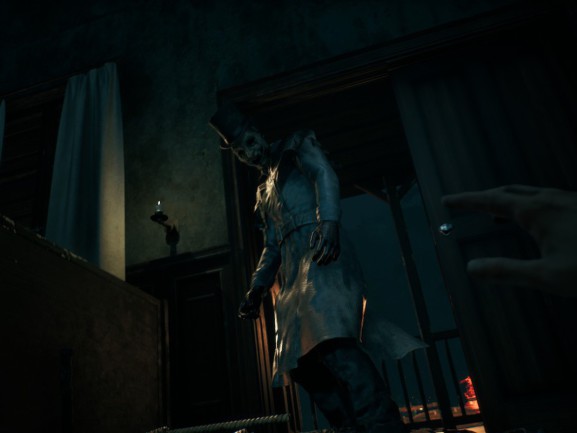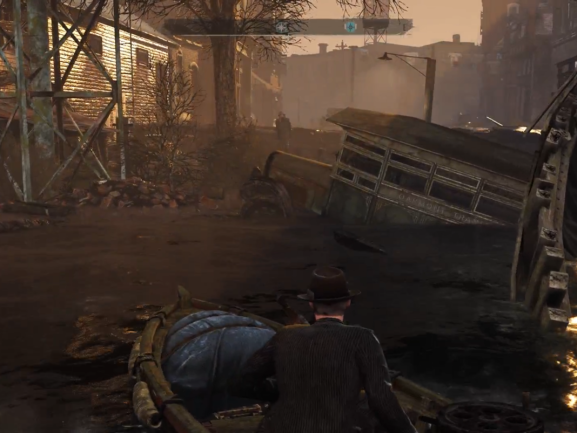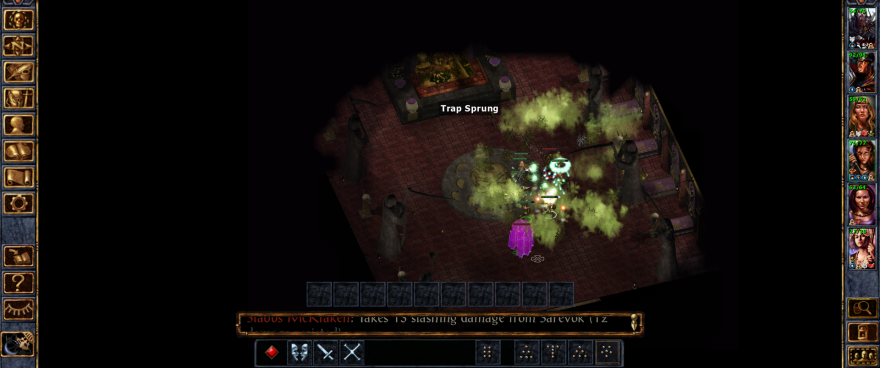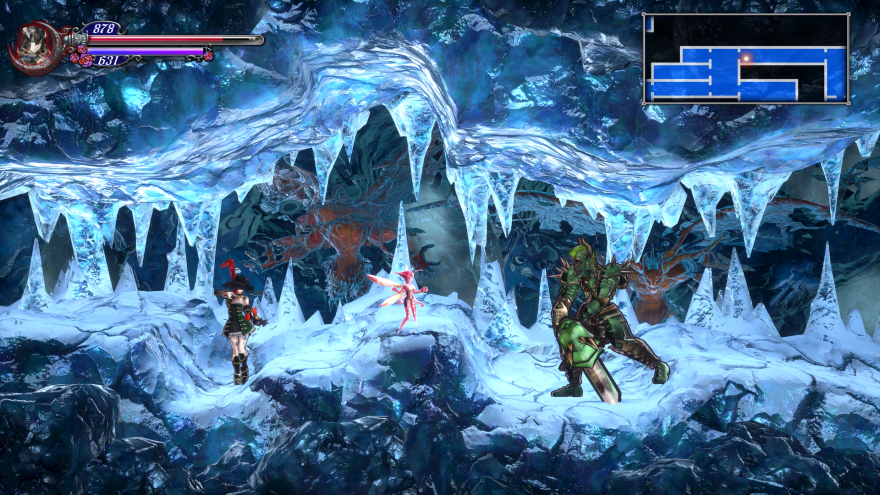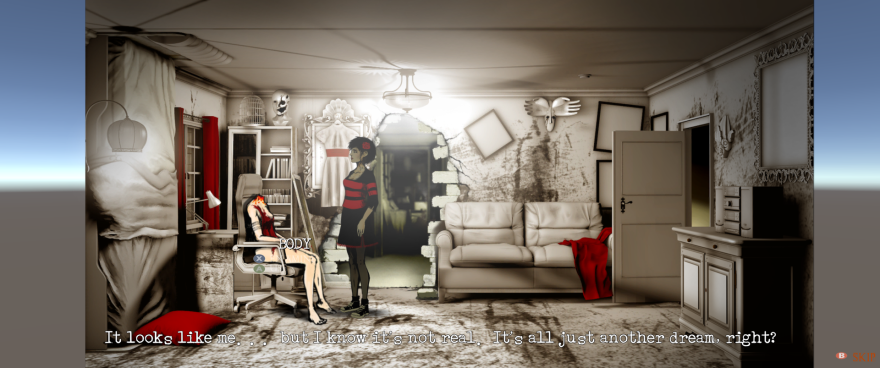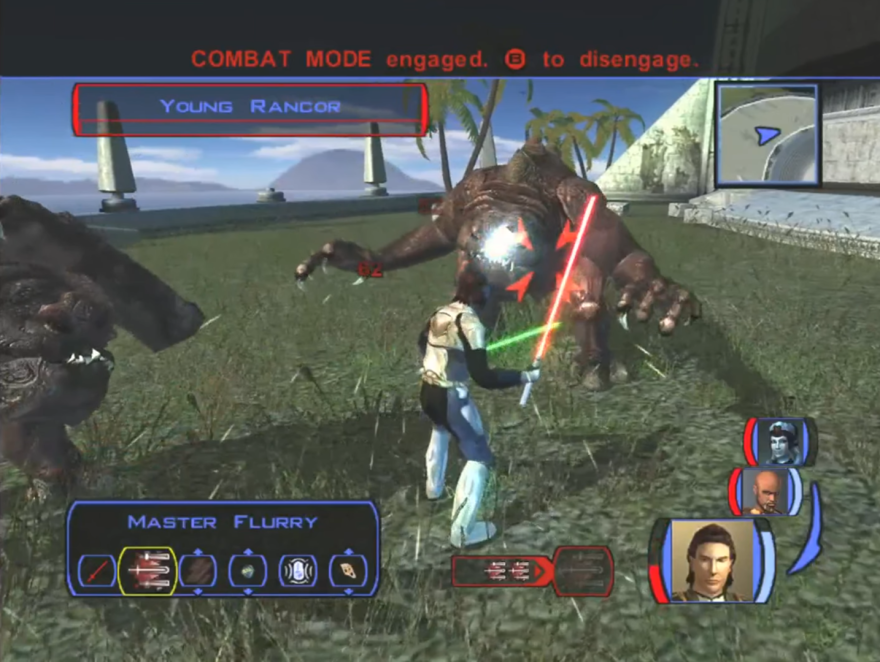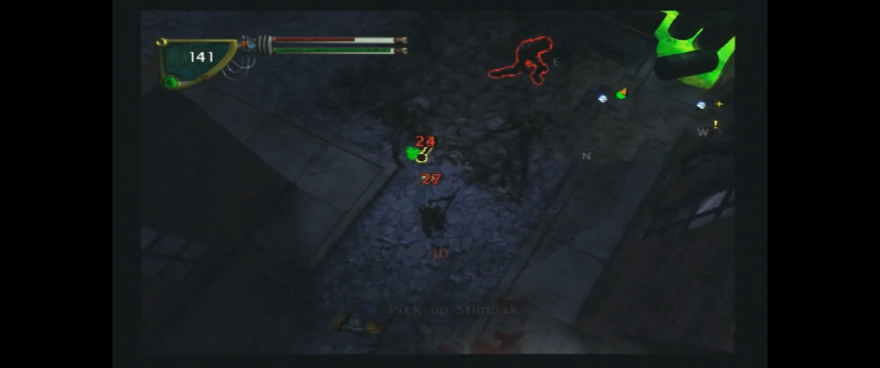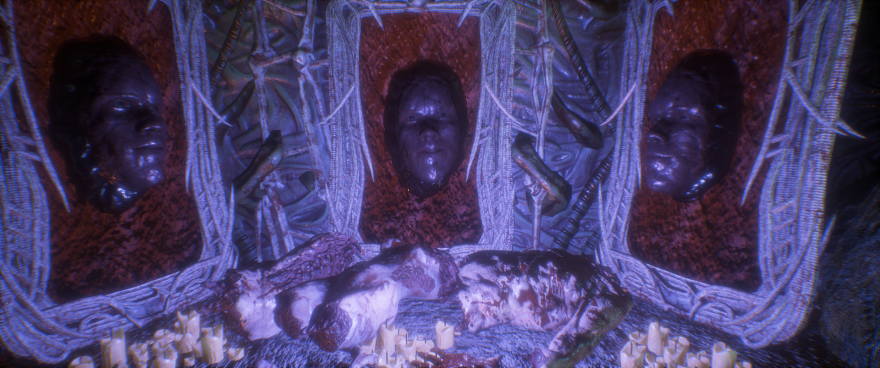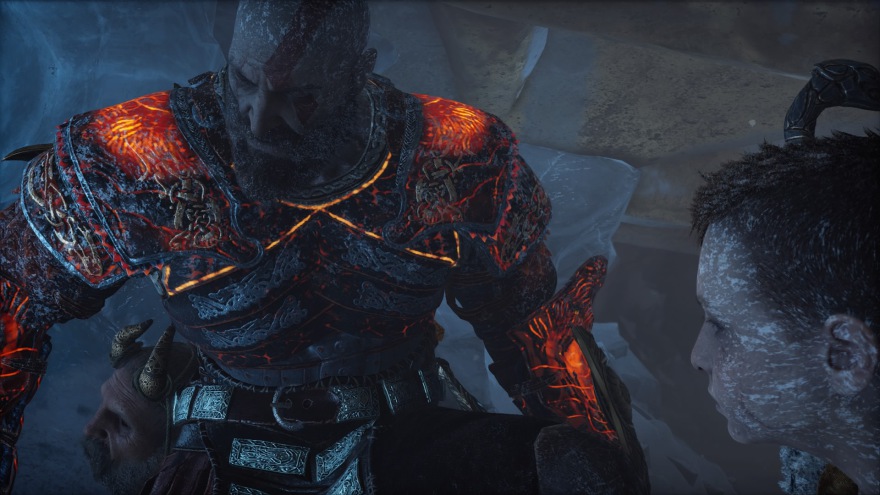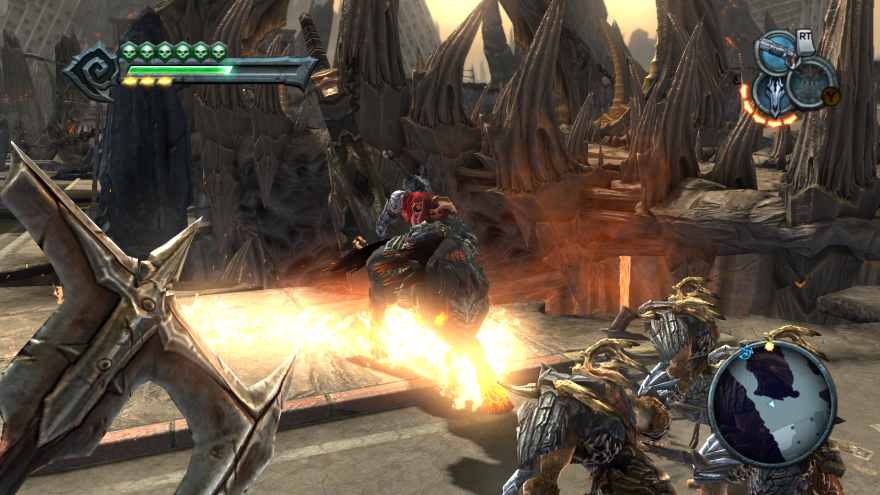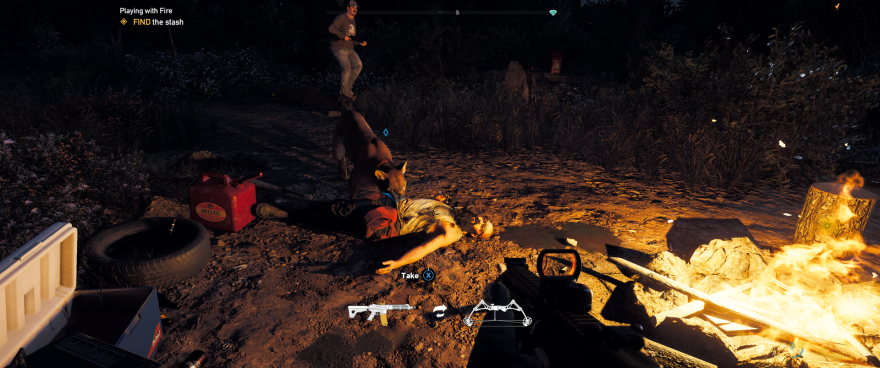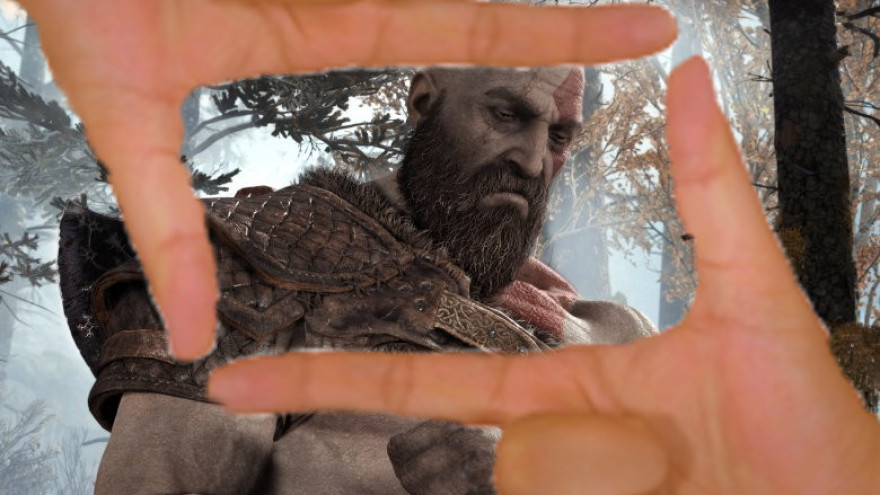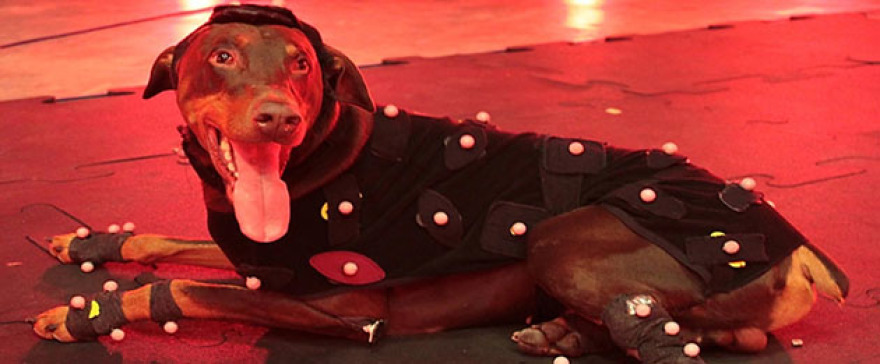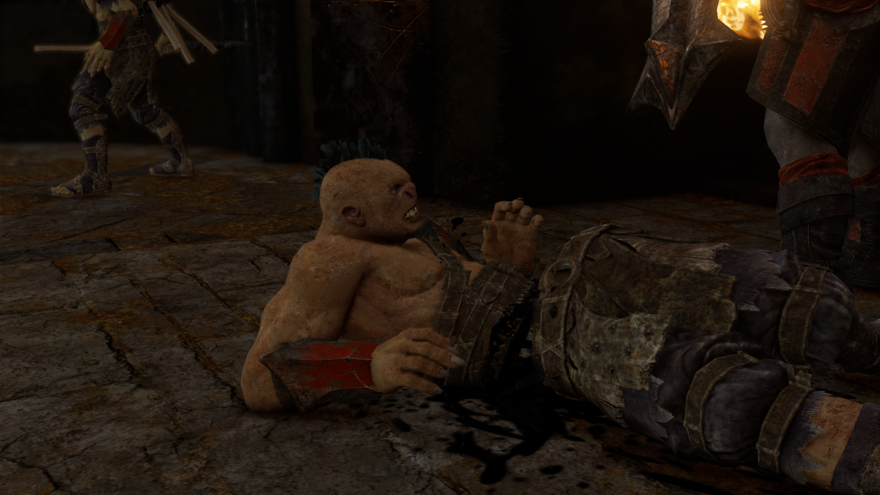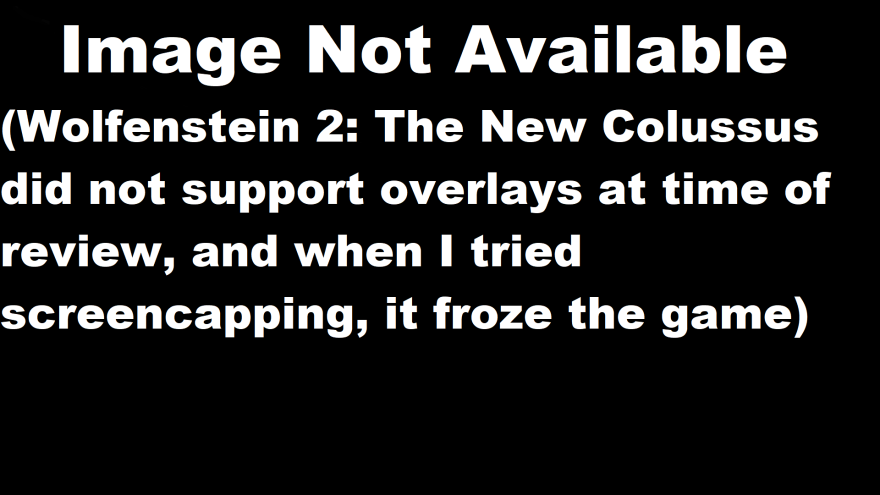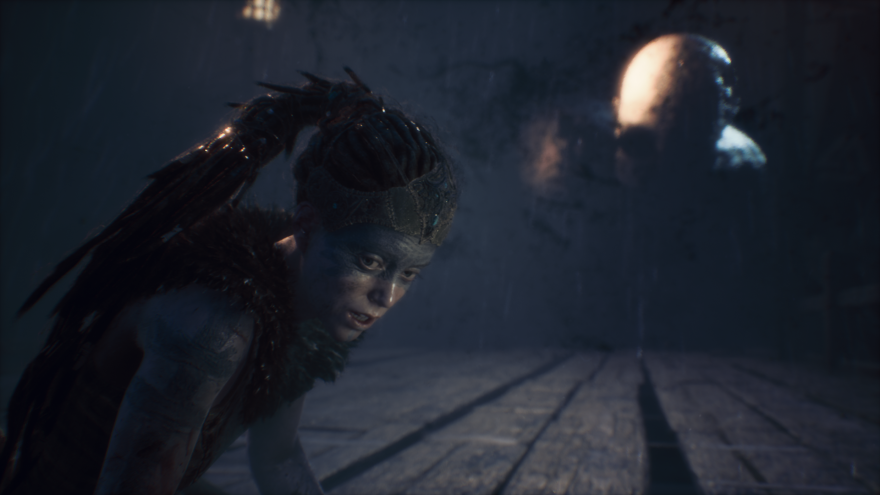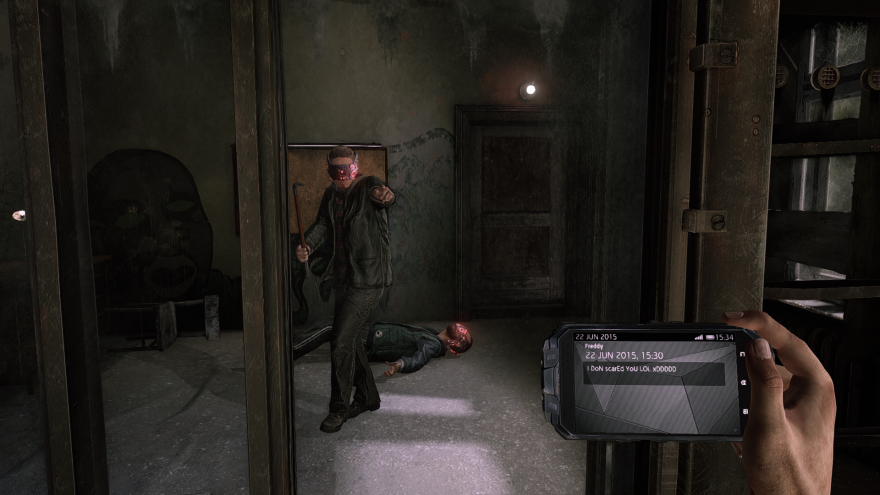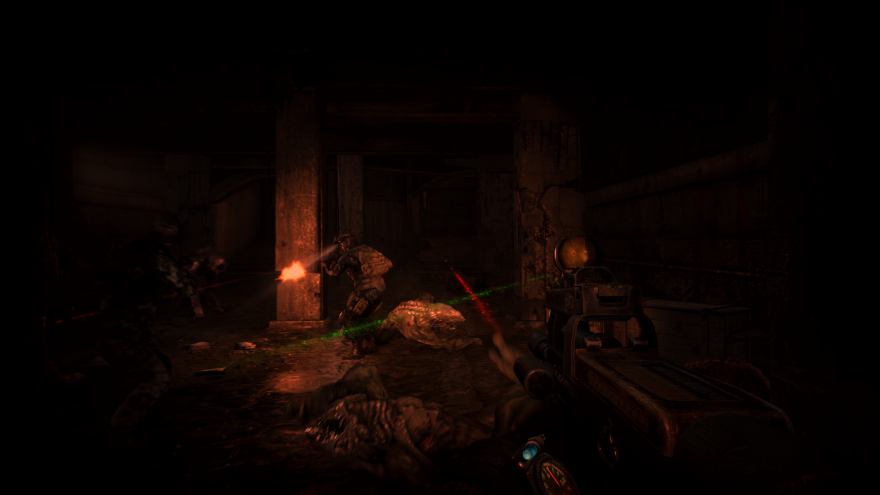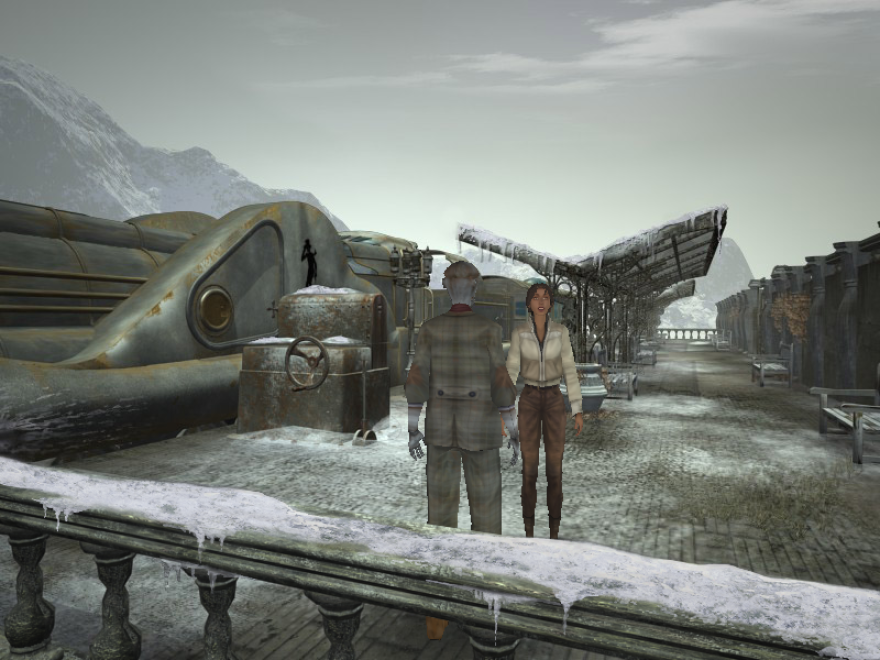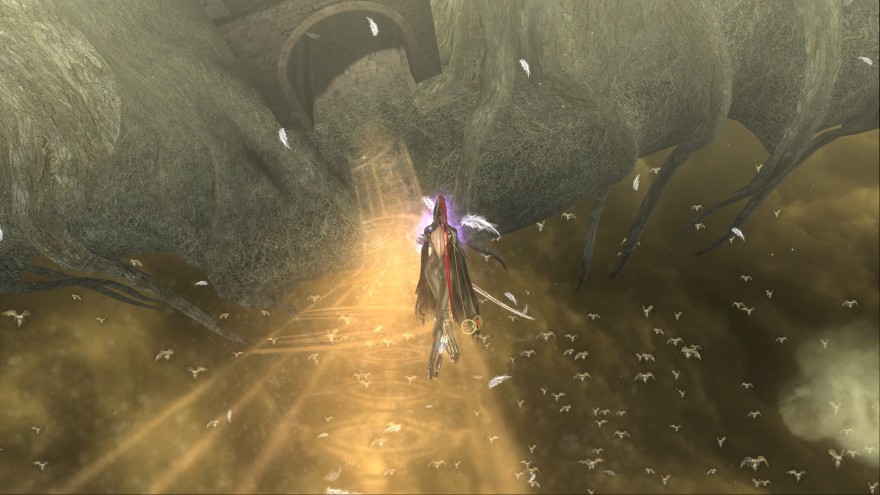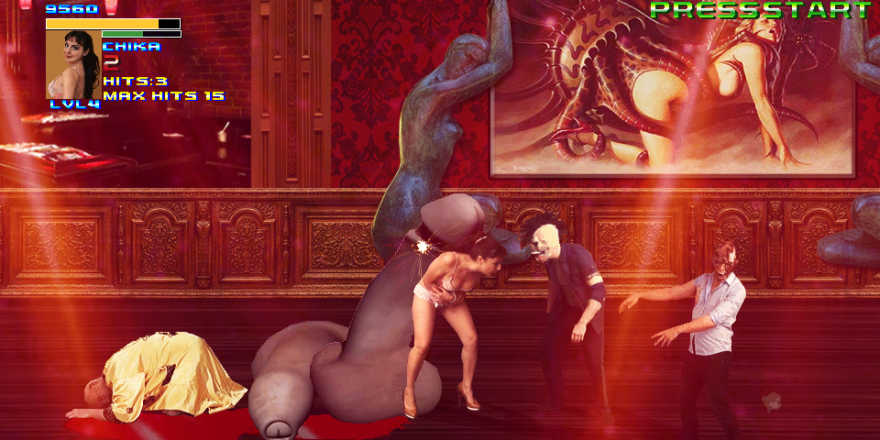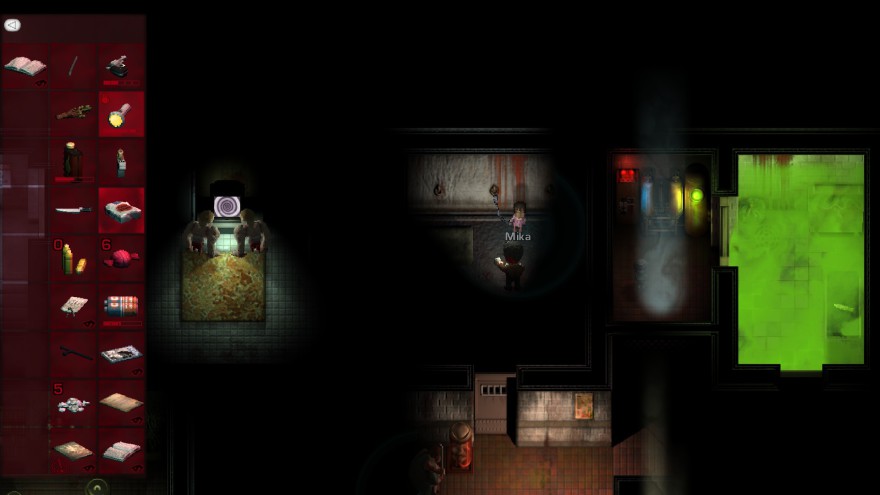Since 2015
Links to stuff:
AbsoluteDeicide's Mixer Channel
AbsoluteDeicide's DLive Channel
Now Playing:
Nioh
Resident Evil 3
Ori and the Will of the Wisps
Why?
What is the point of this site? There's a million gaming blogs out there, as well as dozens of "professional" joints... why make another? What's the need?
Well...
•I've yet to find any sites that reflect my opinion.
"Everyone has different tastes", sure. I can respect that. I also can't help but get the nagging feeling that there's a homogeneous "taste" in mainstream gaming media. I listen to a
number of gaming podcasts and visit a fair amount of sites, and there's an inescapable air of solidarity. I can't count the number of times a topic is brought up only to have a half dozen
hosts/journalists all circle jerk in agreement no matter how divisive the subject matter. They all seem to be cut from the same cloth and in a business based primarily on opinions there seems
to be one "right" school of thought you must agree with or face being fired/ostracized.
And no, I'm not part of the "Gamergate" crowd or whatever. I'm not part of any crowd... that's kind of the point. I just think Gone Home is a complete piece of shit and zero alcoholic,
Southern California-based journalists who hang out with each other at events, met the developers, and were given the game free of charge agree with me. So fuck them. They're way off base
or out of touch with my "tastes". (more...)
State of the Site
10/19/2019-
It's been Jocktober for a couple weeks. Thought you should know.
8/1/2019-
If you're one of the two people who watches my live streams and you're wondering where I am in the next four days: I am on sabbatical. I recorded an early podcast to keep you company. Will be back Sunday. Gone fishin'.
7/2/2019-
Due to rain, the podcast is moving to Saturday releases for the indefinite future. Also, we'll be playing/streaming games the same time as the rest of the unwashed masses- Monday thru Friday in the afternoon/evening. Plan accordingly.
6/23/2019-
If I write any more reviews, this might turn into a video game website or somefin. Tss tss tss.
5/14/2019-
We made it. Episode 200 of the Grunt Free Press Podcast. Some said it couldn't be done. Some said it shouldn't be done. But mostly no one said anything. Against all odds...
I also have vacation next week, so if I don't manage to write ONE fucking review in that time... You know I'm a complete piece of garbage.
1/8/2019-
It's 2019 now.
10/23/2018-
Having some technical difficulties uploading newest podcast (Episode 171) to site. If you're rearing for the latest in spooky audio, it will be availible from Internet Archive, iTunes, Stitcher, iHeartRadio... whatever the fuck else I use, I don't even know anymore. Hopefully will be fixed soon.
6/6/2018-
Yes, that's a review you see. Of a shitty game. Goddamn, Agony is bad... I have plenty more reviews (of better games) I should write. Nobody said they have to be good.
5/15/2018-
New podcast are out, recorded with a new mic, which means new problems. Or old problems renewed. Namely: the levels are all fucked up. I'm working on it. In the meantime I'd suggest turning the volume down to make it at least somewhat listenable.
3/23/2018-
Wrote an "opinion" piece on the new God of War. Starting to have serious misgivings about creating "columns" for the top of the website... Looks good, like an old-timey newspaper column on desktop, looks like shit on mobile where you have to scroll through these stupid updates every time...
Also can't add anything other than text or photos in the columns. Wanted to add a video clip of The Shining, had to settle on still photo. Note to self: change it when the article moves past the column section. Also note to self: read this note on mobile, so you're forced to scroll past it...
I also learned how to use Photoshop (or the free equivalent, Gimp... because I'm a poor sack of shit) in about an hour to make the picure for said article. Not bad, if I do say so myself.
1/14/2018-
New review is up. And by "new", I mean a game from 1985. When there's jackshit coming out for new releases, you have to fall back on the classics.
1/2/2018-
Happy 2018... which started off by this site reverting back to October of 2017 for some reason... I call shenanigans. It's fixed now.
11/2/2017-
Been awhile since an update, but it's been awhile since I had anything worthwhile to write... like Wolfenstein 2 is hot garbage. It is. Review is up.
7/18/2017-
Back to the badlands of Defiance and further back to the American Revolution in Empire: Total War. Grunt Free Press Podcast Episode 105 is out, despite the summer slowdown of games. We'll make due. And the forum mysteriously has disappeared... I'll fix that eventually. Maybe.
6/20/2017-
Grunt Free Press Podcast 101 is out, painfully detailing every E3 announcement, because E3 happened.
5/28/2017-
Just got back from Fun Spot. Recorded a podcast you should check out for the full rundown. Vacation is winding down. Didn't do jack shit, so that's always good. Friday the 13th is finally out. I'll probably do that.
The Beast Inside Review (PC)
The Beast Inside is a tale of paranoia, madness, and secrets. Much like the plot within, the game itself is easy to overlook and dismiss; Knowing nothing about it going in, it will most likely initially register as another dime-a-dozen, indie, “Boo haunted house”, low-effort cash grab that litters Steam at a rate of about fifty per day. To the contrary, it turns out to be a highly polished, ambitious, grand in scope horror story that stands with some of the best of the genre, using all the tools at it's disposal to keep you on edge and engaged for it's thrilling, brilliantly paced ten hour playtime. Also surprising: it has nothing to do with werewolves. Or Gabriel Knight.
Stuck on a particularly head-scratching encrypted Soviet telegram, Bostonian Adam Stevenson brings his expecting wife Emma to their new home in the remote wilderness of Blackstone, New Hampshire. The serene forest backdrop seems an ideal place to both raise a family and keep them safe from the inherent dangers of his job as a CIA cryptanalyst. Not long after bringing the first few boxes inside from the family car, Adam starts to discover his isolated family estate may have been abandoned for a reason. He unearths a journal from his great, great grandfather, and as he reads the ghastly accounts of murder and mayhem that occurred on the same grounds his world starts to turn upside down in a parallel downward spiral.
What could have been a pure, Amityville Horror-esque narrative about the couple dealing with supernatural entities in their new house becomes much more complex, mature, and interesting as you hop time periods, controlling both Adam in 1979 and his ancestor Nicolas in 1864. Adam's already small group of trusted friends and co-workers gets smaller and smaller as he tries to parse Cold War paranoia from legitimate threats stalking his family. Meanwhile, Nicolas fights for his life, taking a revolver and a kerosene lantern to track down a man in an overcoat and top hat who seems to bring death and destruction in his wake.
The house and immediate grounds are intricately dense and detailed. Most drawers and cabinets can be slid open, many objects can be picked up, examined, and comedically thrown out of open windows. Any important objects are fortunately highlighted, so you're not combing through a messy mansion aimlessly. The only consumable inventory items to worry about are matches, kerosene and the occasional bullet for Nicolas, but those are in such abundance it becomes trivial so you can focus on exploring and your immediate self-preservation. The combination of physically moving the mouse to interact with the environment and periodic quick time event add to the realistic setting of The Beast Inside and helps sell the visuals. Some smart color and lighting choices keep it playable, as well.
As impressive as the indoor areas are, the hills, trees, and waterfalls of rural New Hampshire are probably the most convincing and beautiful scenery I've seen to date. Even when the game pushes you with a sense of urgency to get back to your endangered spouse, you can't help but stop and admire the rainbow reflecting off a skyscraper-tall cascade of water inside of a cave or the ruined beauty of an old stone bridge crossing a stream. It's this grounded, natural loveliness that both provides a break from the oppressive anxiety of crawling through blood-soaked buildings in the dark, and lets the game earn its jump scares and freak outs.
The Beast Inside pulls from established genre tropes when necessary, not so much copying them as using them as tools to create it's own, unique thing. The puzzles are integrated into the story (it's Adam's job), and are just the right amount of challenge to make you grab a pen and paper for note-taking, but aren't going to halt your progress for long. The chase sequences are exhilarating; there's the real danger that if you are caught you'll be met with a “You Are Dead” screen, but they are straight-forward and scripted enough that the fail states are your own mistakes. Even the extended level where you wield a gun and are forced into constant combat is solid, and the climactic boss fight is also well done. The only sore spot is the dreaded stealth sections... Which should come as no surprise to anyone. It's almost impossible to gauge what will trigger the AI or any indication when they spot you. Besides the screams, the loading screen, and your own curses... There aren't many of these trial-and-error sections and they are mercifully short.
The Beast Inside is a sleeper hit. I'd never heard a word about it until it popped up as a recommended game along with the shit I usually skip past and never think about again. I gave it a shot because I thought it would be bad and about werewolves. It's neither.
The Sinking City Review (PC)
Good games based on the works of H.P. Lovecraft are few and far between. With densely worded descriptions of “unspeakable” horrors you can't even look at and deranged protagonists often retelling their decent into madness through flashbacks and written correspondence, the weird horror legends are usually stories to draw inspiration from rather than adapt directly. Fittingly enough, something similar could be said for Sir Arthur Conan Doyle's Sherlock Holmes character, with the exception of the long-running, excellent series from developer Frogwares. With a basic, established template set for investigative storytelling, that same studio took a crack at bringing Lovecraft's twisted world of fishpeople and cosmic derangement to life. They basically made Sherlock Holmes Versus The God With a Thousand Tentacles.
As private investigator Charles Reed, you follow your haunting, nocturnal visions to the New England island town of Oakmont, searching for an explanation and possible cure to the onset insanity that is afflicting a large number of people on the mainland. Charles is stereotypically deadpan and straight-laced, which stands in comedic contrast to the off-kilter town and it's strange inhabitants. Oakmont has suffered a disaster known as The Flood, and half of the town is being taken back by the sea (The Sinking City). Almost immediately after disembarking from your arrival ship, you're confronted with half-naked natives walking around with tribal markings adorning their bodies, influential businessmen with ape-like features, women who have had their lips sewn shut for punishment, and an underclass of citizens with bulging eyes and scaly skin. Also strange is the fact the KKK has a foothold in New England, which could be chalked up to other-dimensional beings or foreign writers who don't quite understand the finer points of American history, but it's odd nonetheless.
It's slow going at first, and early impressions of The Sinking City are not kind; the graphics are decidedly below average, with character models looking like they came out of a Bethesda game from a decade ago. Walking the Oakmont streets in free roam, the townspeople phase in and out of existence and often glitch through walls or fall straight down into the sea. You also can't perform any meaningful interactions with them- newspaper salesmen, fiskmongers, and street doctors peddle their wares, but you can't buy anything from them. Doomsday preachers shout for passerby to gather 'round, but then quickly shut up when their one line of recorded dialogue is spoken. There only seems to be three or four layouts for building interiors, repeated ad nauseum. It makes you question if the sprawling, open world design was worth it if the game is this rickety.
Charles' investigation techniques have a strict methodology to them; accept a request from a citizen, find a location on the town map, mark it (Oakmonters always give directions by naming a street, then telling you what other two streets the spot is between...), travel there, then use his supernatural P.I. gifts to ferret out any information that will help the case. Aside from the standard detective work like following blood stains and trails and deductive reasoning at a crime scene, Reed has “the vision”, a way to look into another dimension to spot things normies would miss. It's part game justification to pixel hunt for clues and make walls disappear, but it also works in the context that there is something not quite right with Reed or Oakmont. Whenever you tap into that dimension to uncover symbols or follow a trail, your sanity takes a temporary hit, distorting your perspective and potentially spawning enemies that may or not be real.
The horror elements of the game are effective, but slightly underutilized. The aforementioned “sanity effects” quickly dissipate, which is a shame because the drunk visual effect is well done and can even carry over to cutscenes if you happen to be spooked when you go into them. Likewise, the creature designs are satisfyingly disturbing- bony, lanky crawlies that look like facehuggers, melted humanoids that rip their faces apart to spit some kind of goop at you, bloated monstrosities that will charge straight towards you, growling... Even the town's cats are split open and infected with some kind of parasite. But the act of fighting these creatures is just something you have to do to progress, and their threat becomes toothless before too long once you figure out how to cheese them with wonky melee attacks and breaking their pathfinding.
The Sinking City grows on you. The combat may not be technically “good”, but it is serviceable. The side missions may get repetitive as you find notes with addresses, set waypoints on your map, and explore the same buildings looking for the same clues and artifacts. There are obvious flaws in the moment-to-moment gameplay, but after dozens of hours exploring Oakmont, the bigger picture becomes clearer. The town becomes a fully-realized entity, and you are invested in how your actions will affect or destroy it.
It's the overarching, ongoing history of the town and interwoven small stories that makes you want to see The Sinking City to it's conclusion. Frogwares are veterans of telling detective stories and it shows. The narrative pacing gets downright frantic and fittingly oppressive toward the end as you don a diving suit and discover what lies beneath the Sinking City. The field may be criminally underrepresented, but this is arguably the best and most faithful adaptation of H.P. Lovecraft's work outside of literature, soggy warts and all.
Where the Magic Happens:
Powered by Restream.io
Baldur's Gate: Enhanced Edition Review (PC)
Baldur's Gate is legendary. Both the game and even the name of the city if you are the most casual of Dungeons and Dragons fan. Often used as a hub around which major events happen in the Forgotten Realms setting, the popularity of the sprawling urban center would seem to indicate it is of more interest and importance than solely being one of the few names in the D&D lore that is easy to pronounce. After sinking more than fifty hours into the titular, “classic” computer role playing game, I'm not entirely sure why.
This was my third attempt at tackling Baldur's Gate. I had the five-disc CD version released not long after it's initial 1998 debut (Tales of the Sword Coast I believe), and spent many of my formative hours with my face inches away from a computer monitor trying to learn the ins and outs of the second edition Advanced Dungeon's and Dragons ruleset. After exploring the wild forests, striking down bandits and looting their corpses for gold, entering caves with creatures far too powerful for my party to handle, I recall being blown away by how detailed and massive the game seemed to be. I had been playing for what seemed like a lifetime, and I hadn't even reached Baldur's Gate yet!
Then my PC died. It was probably something simple like the power supply shitting the bed. Probably would have been an easy fix, but I was fifteen and had no way of obtaining the parts or knowledge to repair something like that so it was toast. One of the CDs was still inside. I tested my mechanical skills by smashing the computer on a concrete floor, but the disc drive would not give. Even when I got a new(er) computer, there was no way for me to play the game without buying a new copy and my save files were obviously lost. Eventually I did obtain a second copy of Baldur's Gate. While replaying it, my computer became unusable due to rampant viruses and had to be put down. German shizer porn wasn't always available through reputable sites. I became convinced Baldur's Gate was a cursed game, and was trepidatious about installing it again, lest some tragedy befall my gaming devices.
The Enhanced Edition worked well for me. The graphics are updated to look like you remember them originally, and widescreen and ultra wide support is there natively. You can upscale the text so you don't have to squint, and I had no troubles technically. Loading is fast, the user interface is more or less unchanged and a little archaic, but that is part of the charm of playing one of these old school CRPGs.
My early impressions of diving back into Baldur's Gate were incredibly positive; The writing is a nice mix of stereotypical, straight-faced high fantasy nerd speak (which I enjoy) and cynical humor/pop culture references. The side quests aren't particularly engaging, but they are a nice excuse to go out and explore the land. There are an impressive amount of companions to find and recruit to your party, and learning how they compliment each other and add to the group was something I enjoyed. The general flow of the game seemed to strike an enjoyable balance between stat-heavy sim and user-friendly, almost modern conveniences; Yes, you have to rest to replenish your magic users' spells, but you don't need to lug around bedrolls and food. But as the soles of my traveling boots wore down from the road and the nostalgic warmth chilled, the minor pains in the ass became outright ass cancer.
The main plot begins strong enough: Your stepfather, Gorion, warns you of trouble abrewin', escorts you out of your hometown of Candlekeep, and gets slaughtered for his efforts. Witnessing this from the bushes, you heroically search his corpse to find a letter which directs you towards neighboring towns on a breadcrumb trail to expose the dastardly plans of his murderer. You do so, taking up the venerated mantle of “Adventurer”, solving any problem random villagers need assistance with. Iron has become brittle, so you destroy a corrupted iron mine. There are some shady factions about, so you investigate them. That's about it. You don't have much interaction with Gorion's killer until the very end of the game, instead unraveling scatterbrained political balls of yarn that are about as interesting as real world politics.
The various smaller tasks you pick up along the way keep you engaged for some time. At the very least, gaining experience, gold, and equipment is reason enough to talk to any named NPC you find and fight a few ogres. But the repetitious nature soon wears very, very thin... Inventory space and weight is at a premium, so it does not take long at all before your entire party is weighed down and has to make a trek back to a shop to sell their treasure. That's fine, but holy shit is movement on the map slow... When first entering an area, cautiously uncovering the fog of war, it can be tense because you don't know what awaits you. But backtracking through largely empty environments, dealing with some poor pathfinding from the AI, it becomes a major annoyance before long.
Some items will help with the treasure overload, like a bottomless gem bag to hold precious stones and rings, but you still have to deal with the hassle of selecting the party member with the bag, getting her in proximity of the loot, picking it up, go to the inventory screen, drag and drop each item into the bag, one by one... You'll be doing this every few steps in areas heavy with enemies. And there are many of those. Then, even after meticulously looting and organizing and amassing a fortune... There's barely anything worth buying! Despite the aforementioned attention to detail and having scores of unique, named, magical equipment with history behind each item, the loadout of your endgame party is going to be underwhelming. +1 or +2 this or that versions of your starting items, more or less. You're never allowed to grow too powerful, and even mid-range shit enemies can roll over you if the dice don't roll in your favor.
Yes, this is a digital version of a pen-and-paper role playing game, so some randomness is to be expected. But goddamn it is it a frustrating system to play in a video game. The combat is bad, to be blunt. Using the “pause and play” rules ubiquitous with the Infinity Engine, when you press Space Bar, the action stops and you can issue commands to your party members, then unpause and watch everything play out. The sheer amount of micromanaging required to try to make this work is retarded. Six party members, all with (hopefully) unique strengths and abilities that you have to babysit after each turn, otherwise they will stand there and let a goblin gnaw on their face. Or they won't. Sometimes they'll attack on their own and use spells in the right situations, sometimes they sit there waiting for your command, and sometimes they decide to completely ignore what you tell them to do.
After trying to “master” the tools provided by the game and failing, I looked up some advice for the battles that were giving me the most trouble. When these games have been out for decades, studied and analyzed, and walkthroughs suggest, “Yeah, shit's really random. Save and load a lot.”, it's safe to say the combat is garbage. Save scumming is not an elegant or enjoyable game mechanic. Most obnoxious of all is the reliance on higher level foes to use holding or tripping spells. If your party fails their saves (and they will), you completely lose control of them and have to sit there for several minutes until they either die or break free. Gay.
The narrative and complimentary writing of Baldur's Gate could warrant a recommendation to look past the grating combat, but there is a whole lot of unavoidable combat in the game. Thankfully the Enhanced Edition includes a “Story Mode” difficulty you can turn on or off at will to get past the most egregious of bullshit, but if you have to fall back on turning on God Mode to skip past what should be the high points of the game can you really consider it “good”? I don't think so. This kind of nonsense may have been considered a worthy challenge in 1998, but anyone contending gameplay this flawed is okay for a “timeless classic” must have had a high level Charm spell cast on them.
Bloodstained: Ritual of the Night Review (PC)
Bloodstained: Ritual of the Night is the “spiritual successor” to Castlevania: Symphony of the Night, and if that sounds like something you are interested in it shouldn't be missed. It's exactly what you think it is: explore a gothic castle, fight demons and an assortment of strange creatures, level up and gain equipment and abilities that will allow you to progress deeper into the castle... Repeat until the credits roll. Aside from some aesthetic differences and slight changes/additions to the tried and true “Metroidvainia” formula, the game is on par with what you expect from learning: “The director of Symphony Kickstarted a game in 2015.”
You play as Miriam, a Shardbearer who was destined to be ritually sacrificed to ward off a demonic invasion that occurs every ten years. Right before this was scheduled, she fell into a mysterious slumber which prevented someone from stabbing her to death for some reason. When she awakens with a slight case of amnesia the Hellspawn have indeed infested her version of eighteenth century England, and she takes it upon herself to find a way to rid the world of darkness. That involves slaying thousands of creatures, plundering cathedrals, and ingesting crystal shards to increase her power.
The plot is more complicated than it has any reason to be. Besides a handful of short cutscenes using the game engine, dialogue between characters is delivered through decent voice-over with static, hand-drawn portraits. This would be more than fine if the interactions were snappy and brief, but the high frequency of exposition only serves to bog the game down. Exploration is the be-all and end-all of this genre, so trying to hold mental notes of the map, remembering which door needs which key and where you need to backtrack... Then being stopped dead in your tracks to listen to ten minutes of nigh-incomprehensible drama about Enochian text and crystal shards does nothing to keep your flow going. I couldn't quite bring myself to hit the “Skip Scene” button, but I checked out within an hour.
The sheer amount of options at your disposal is impressive. Dozens of armor, weapon, and cosmetic collectibles can be crafted, purchased, or found in the castle. Then you obtain a massive list of Shards on top of that, which range from passive abilities like increasing your damage output to special traversal techniques you will need to progress or access the many secret areas in the game. These upgrades are handed out so often it almost becomes overwhelming. I just found an offensive and defensive Shard combination that worked for me and stuck with it for the majority of the game, upgrading them when I could. Optimizing your abilities and equipping the right ones to exploit enemy weaknesses is probably required on the harder difficulties, but on Normal having ghostly paintings surround you while you project a giant drill though walls works ninety-nine percent of the time.
That's not to say Bloodstained: Ritual of the Night is easy. It's not. I'm positive I died more times on the first major boss than I did in the entirety of Symphony of the Night. Standard enemies will drain your health bar at an alarming rate, and the action does feel a little stiff. The 3-D assets can be extremely difficult to read on the 2-D plane you are playing, leading to missed jumps and misjudging your attack range. The deadliest attack many of the bosses possess is walking into you while you try to decipher exactly what you're looking at. Graphically Bloodstained is not a bad looking game, but it's a bit busy and colorful to the detriment of it's gameplay. Thankfully you can level yourself up and win wars of attrition if needed, but I never felt like I was in complete control of Miriam. Some spotty hit detection and enemies frequently clipping through walls doesn't help things.
While clearing out the massive map is pure, nostalgic comfort, there are a few instances I ran into that were much too esoteric for my liking. It's fantastic that secrets and Easter eggs are plentiful, but on more than one occasion I was forced to consult walkthroughs and forums because the main path was at a standstill. Upon reading the solutions, I didn't feel like I had cheated myself at all... Some key items are easily missable, certain “clues” won't even trigger in NPC dialogue if you don't explore in a “proper” order, and even then the instructions given to you are more akin to Castlevania 2: Simon's Quest than anything. If you don't plan on playing Bloodstained for the rest of your life, have an internet tab handy...
Bloodstained: Ritual of the Night is janky in places, decidedly low-budget for it's scope, and is weighed down by some unnecessary bloat like planting and harvesting corn. It does scratch that Symphony of the Night itch, though. If you enjoy squinting at a map, searching for that one door you didn't go through ten hours ago, Bloodstained is what you are looking for.
Lorelai Review (PC)
Lorelai is the third (and possibly last) game in the “Devil Came Through Here” series, which began with The Cat Lady and was followed by Downfall. Though interconnected with themes, locations, and characters, each game stands on it's own as a disturbing, shocking, surreal adventure through isolation and depression. They are dark and filled with dream logic, but manage to be more “real” than most other video games would be comfortable with. Even if you think you can handle horror, Lorelai will haunt your soul from a much deeper realm than any stock jump scare game ever will.
Lorelai doesn't have a happy life by any standard. Beyond the typical teen angst, her father died of cancer, her mother is a clinically depressed chain smoker who's lost the will to live, and her stepfather is an unemployed, abusive drunk who likes to piss next to Lorelai's head. Even worse off is her baby sister, who is routinely neglected by everyone besides Lorelai. While dreaming of escape, the already horrendous situation escalates rapidly and Lorelai ends up dead. This is where her journey begins.
Though at it's core an adventure game, don't expect many head-scratchers or challenge here. The controls are incredibly simplistic, the areas you explore are fairly compact with very few interactive elements, and (as far as I know) there are no fail states. The focus is on the story and excellent dialogue, and not having obscure inventory puzzles to get in the way is most welcome. You do have some choice in how the story plays out through choosing words or actions that effect your Karma and eventually the ending, but the “game” elements of Lorelai are there to poke at your morality rather than test your skills. And to that end they do the job quite well, forcing you to choose between different shades of gray.
For such a dark game, Loreali is a looker. A unique mixture of 2-D, hand drawn art and some 3-D assests, there is enough variety in the visuals to keep you excited to see what the next sequence will bring. It's quite colorful, too. Playing with oversaturation and digital artifacts, there is no limit to the creativity on display. It stretches the gamut from “cheap looking” to surprisingly sharp and polished, but it is never boring. If you happen to be playing in an ultrawide resolution there will be some odd things on the margins you're definitely not supposed to be seeing, but a random train or ten-foot tall, second Loreali kind of adds to the absurdity so I'm not complaining about it.
Equal to the visual diversity is the assortment of scenarios the game runs you through, and the emotions each scene conjures. I never thought a story about suicide, hopelessness, and shaking babies would make me belly laugh so hard. While Lorelai goes out of it's way to avoid being stereotypically “game-y”, it's littered with gaming references and satire. The self-awareness and self-referential humor would be obnoxious in lesser hands, but it's done in such a way that it goes well beyond winking at the player and meme culture. Having an in-game character that is a game developer shitting on the garbage heap of Steam releases like Ice Cube Simulator and lamenting how he had to make a zombie game to find commercial success might be a tad masturbatory, but goddamn is it funny.
One moment you'll be following Lorelai on her first day of work at a nursing home, following her colleague's instructions during her rounds. Walking room-to-room, you wash and feed elderly women in a grounded, sober environment. Not long after, you're using a painting as a portal, eating shark fin soup to resurrect, and trailing a lonely man to Alcoholics Anonymous meetings as a ghost, sitting next to him to watch Night of the Living dead because you feel bad. Once again: pacing this jerky and schizophrenic could easily be a negative, but all of the disparate pieces fall into place for Lorelai. They're just where they are supposed to be.
Like the two games before it, Lorelai is a mature, haunting work of art. There is something ethereally special here that feels genuine and important. Whether it is or not is as ambiguous as the ending, and that's exactly as it should be.
Star Wars: Knights of the Old Republic Review (Xbox)
A long time ago, in a galaxy quite like our own, Star Wars was a beloved franchise with a hardcore fanbase eager to gobble up any media outside the main three movies (of which Return of the Jedi was the “bad” one). There wasn't exactly a shortage of books, toys, or video games based on the Western space opera, but the auxiliary material was either a recreation of the films we knew and loved or something original that expanded the universe and was to be studied and discussed. When a then-respected RPG studio was given the license to create a de facto history, set thousands of years before the events of A New Hope, nerd interests were piqued. Some real world years later, Knights of the Old Republic remains a nostalgic marker of an elegant, slower game for a more civilized age. Just don't bother trying to get the game to run on a PC, that shit is a mess. The original Xbox release played backward compatible on Xbox One is now the definitive version.
2000's BioWare certainly had a formula it applied to most of it's games, and Knights of the Old Republic is where they built the foundation. You lightly customize a player character by choosing an avatar and occupation, put some points into his or her attributes and skills, and you're on your way. It's not long at all before you meet up with companions who will tag along with you, who you can also customize to compliment your skills and fill any gaps the party may have. During combat you can queue up actions by pausing the action and stacking commands, then unpause to watch the battle play out. Hits and damage are still determined by behind-the-scenes die rolls, so KOTOR is very much an evolution (or dumbing down, depending on who you ask) of the classic CRPGs that came before it.
Your character awakens on a Republic starship as it is being attacked by the Sith, and he has very little memory of anything before that. You fight your way to an escape pod and crash land on the nearest planet, Taris. From there you are tasked to find your commander, the Jedi Knight/pompous bitch Bastilla, uncover your past and latent Jedi abilities, and retrace the steps of current year evil Malak who is using a mysterious, alien technology called the Star Forge to manufacture an unstoppable fleet of ships and battle droids to rule the galaxy. If that sounds like a lot to take in, don't worry; Knights of the Old Republic takes it's time explaining in granular detail the history and meaning of each alien culture you encounter and what consequences your actions will have. Multiple times over, in most cases...
The early hours of KOTOR is brutally, glacially slow. The first ten or so has you trapped on Taris, talking to any named NPC you encounter, searching for any kind of plot thread to grasp onto to move things along. If you're a superfan (as I was in 2004), you may find the exposition interesting and be charmed and appreciative at the authentic alien languages spoken by the denizens. After running through the same-y looking, barren, gray corridors for the twelfth time, reading the same information regurgitated slightly differently in a marginally less (or more) annoying alien dialect... You really need some faith in the Force to believe it's going to pay off. It does, with one of the best and most famous twists in video game history. The back half really picks up in every way, but patience you must have.
Once you have access to a ship (The Ebon Hawk), you can travel to four planets at any time to search for pieces of the Star Map. To find the Star Forge. Because it's Star Wars. Staying true to the source material, each planet has a single biome to keep it distinct; the water world of Manaan, the volcanic planet Korriban, the Kashyyykian forest, and the desert of Tatooine. While they aren't particularly large play areas, they do well to have their own, standalone plot lines and histories and politics. Which you will hear about at length. Or read about... because they do go overboard with the alien languages. I don't mind subtitles for movies, but in a forty hour RPG, where three-quarters of the dialogue is text, your eyes get into the habit of immediately drifting down to read whenever a character is speaking to you. When you do finally talk to NPCs who speak Galactic Basic- usually at key moments in the story- KOTOR may as well be a text adventure. Which is a shame, because it is a good looking game. Bastilla looks hot when you make her run around in her underwear. So she can access the Force better.
Depending on which planets you visit in which order (and how you tackle the quests and handle your credits), the combat encounters in Knight of the Old Republic can be quite punishing at times, or so easy it's a joke. The early goings are rough. You're scraping money together to afford a couple medpacs, and each attack roll could mean death if you miss. Enter the arena on Taris and you'll quickly learn that spamming stimulants and grenades can get you out of dire situations. As you progress, however, your power and equipment upgrades cascade into making you a murder machine. It's good RPG design, though not exactly balanced as a random difficulty spike or one hit kill puzzle will spring up out of nowhere. So save often like the Sith scum you are. Some of the side quests are also bugged and unsolvable, but I didn't run into anything game-breaking.
There are also a couple brief but enjoyable mini-games to break up the routine of: talk, talk, talk, kill, Star Map. There are three Swoop Racing circuits, offering a multi-tiered time trial on a simplistic track. Occasionally when landing on a planet, the Ebon Hawk will be assaulted by Sith ships. This triggers a turret sequence where you just have to aim at the ships and shoot them. Not very deep, but it's an okay diversion. Then there is Pazaak, a blackjack variation where you build a custom deck of numerical cards to add to or subtract from your score, trying to get close to but not go over twenty. Something about Pazaak is extremely addictive, and you'll be hearing the card buzzer in your sleep. This is a good way to quickly gain or lose a lot of credits. Control... You must learn control.
It's hard to recommend Star Wars: Knights of the Old Republic to someone who is not a Star Wars fan. The alien gibberish would most likely seem fucking ridiculous, the pacing in the early (dozen) hours can be painful, and some of the puzzles involve solving algebra for no reason. But, it is one of those games where if you stick with it, become the Jedi you were meant to be, and learn to skip through the ear-splitting alien non-sense once you've read the subtitles, the story truly is one of the best ever told in a video game. And as someone who generally doesn't give a shit about story in games, it's a solid RPG to boot. And it's Star Wars from when that meant something.
Fallout: Brotherhood of Steel Review (Xbox)
“Fallout: Brotherhood of Steel is not a Fallout game!”, cried the autistic hordes of post-apocalyptic role players when the game first launched. Pre-Fallout 3 (which was also not a Fallout game according to the same gaggle of tards), anything bearing that name that wasn't a turn-based, dialogue-heavy, 40-plus hour campaign with an absurd amount of branching paths was blasphemy. Much maligned by both critics and the gaming public at large, Fallout: Brotherhood of Steel came and went and was hoped to be forgotten by time. I thought it was alright. And it's still pretty fun to play. It's not even the worst Fallout game with “Brotherhood of Steel” in the title...
Although Brotherhood of Steel is a 3-D, overhead action/RPG very similar in structure to the countless “console-ized Diablo-clones” of the day (Baldur's Gate: Dark Alliance, A Bard's Tale, etc.), it's tone and comparatively impressive variety of weapons makes it quite a bit more enjoyable to go back to than many of it's contemporaries. It's an easy game to pick up and play, it rewards aggressiveness, doesn't take itself seriously at all, and also knows just when to mix up the mindless hack-and-slash-or-shoot action to prevent it from becoming repetitive. For any other criticisms you can levy at Brotherhood of Steel, poor or thoughtless game design isn't one of them.
After a cutscene recapping the basic setup of the Fallout universe (war is bad and there are mutants now), choosing one of three characters with the expected strengths and weaknesses, and a T.S. Eliot quote, the first NPC you encounter is a prostitute with really nothing to say besides a proposition to fuck. That should clue you in to what to expect from the game as far as characters go. It should be noted that you can enlist the whore's services regardless of whether you are playing as a male or female, so progressive points there. The rest of the game is laden with immature humor that is not particularly funny and cheesy metal riffs from a surprisingly big name soundtrack including Slipknot. Unfortunately they couldn't find a way to play anything but ten seconds loops of each song. Tonally the game screams stupid, amateur teenage metalhead, and I'm not ashamed to say that's one of my favorite aspects of the Fallout franchise.
Even if the majority of character interactions are nonsense, the larger plot about a mutant menace cropping up in the wasteland will be familiar territory for fans. Brotherhood of Steel is almost a truncated retelling of the first game, hitting briefly on facsimiles of locations and characters, then shuffling you along to the next location to bash more radscorpions and ghouls with your super sledgehammer. Nothing all that noteworthy or philosophical happens, but this is an action game.
What is most important for an action game is that is controls well, and Brotherhood of Steel is fast, fluid, and satisfying. The weapons are broken up into three basic categories; melee, ranged, and explosive. You can equip any three at a time for quick access via the black and white buttons. Wading into a mob and cutting them down with knives and hammers and baseball bats works well, with your attacks having a wide arc and each close range weapon having a unique feel and hurtbox. More advanced melee tools can also be charged up for a deadly spinning attack. Shooting is also viable and sometimes necessary, and landing your bullets is easy to achieve thanks to a lock-on feature with the right trigger. This allows you to dodge with “Y” and a direction on the stick. There is some strategy involved if you want to play optimally, getting your hits in and cartwheeling out of the way when the enemies return fire. It may not be tactically deep, but it demands your attention at all times.
While you are playing as a pre-made character, the skill tree is fairly expansive for a game in this genre. As you gain experience points and level up, you can sink skill points into bonuses for specific types of weapons, discounts at shops, or more exotic perks like summoning a canine companion or healing yourself with radiation exposure. Most of the upgrades take the boring route of statistical percentile increases, but over time you do feel some ownership over your build. Each of the three starting choices have a few perks unique to them, and as you progress through the game you gain access to an additional three secret characters. You can also import them from any previously saved game, so the possible combinations to choose from and the replayability is quite high. The entire game can also be played cooperatively, too, of course.
Fallout: Brotherhood of Steel's graphics are fucking awful. You often have to squint and let your imagination run wild to even begin to guess what the fuck you are looking at. While it's certainly serviceable from the top-down perspective (when you are playing the game...), it probably wasn't the wisest idea to use in-game graphics for cinematics. The textures are muddy, the polygons are countable, and the art style is horrid. There is good visual variety in the levels, but that can mean anything from "clean and readable" to "so dark and brown you're relying exclusively on the mini-map to move around".
The game looks bad, it sounds bad, and the story isn't good. Yet I had a blast the entire ten hours I was playing through it. It may be a generic action/RPG with a Fallout skin loosely applied, but it takes just enough essence from the license to make something unique, flirting into almost so-bad-it's-good territory. And most importantly it's fun, so pull the stick out of your ass.
Agony Review (PC)
Agony sucks. Even giving the game the widest berth possible for being low budget and swinging for the fences with a singular emotion it's trying to convey, it's not a good game. Technical issues aside, questionable puzzle designs, taking away almost any subjectivity you conceivably can when reviewing a video game... Agony is a bad game.
In broad strokes, the concept of Agony sounds right up my alley: it's a first person horror game that draws inspiration from the works of H.P. Lovecraft, attempting to visualize the “unspeakable horrors” and non-Euclidean geometry through a mind-bending journey through Hell itself. There's very little in the form of concrete story other than to find some Red Priestess and see where it goes from there. Everything about Agony is supposed to disorient, discombobulate, and disturb you. There's a small hint of that here and there, but it's usually not the way the designers intended and it's more likely to just piss you off because it's shitty.
Every now and then the game looks good. Certain areas stand out with multi-colored lights painting an interesting, twisted environment made up of flesh, bone, blood, and teeth. After slogging through the majority of the overly dark and muddy visuals, it's impressive to come across a section that looks like someone took the time to properly make into some kind of artistic display. Otherwise it seems as if Lovecraft's “indescribable” adjectives were interpreted to mean, “Drag a bunch of crap around in a map making tool.” The assets are repeated ad nauseam, each level using them more poorly than the last. By the end of the game it's random crap thrown together, and textures you're not sure are even loaded in properly. And some of those textures will instantly kill you if you touch them. Again, definitely NOT as intended.
The early levels show some promise: you're using a torch to burn away obstacles, hiding from indestructible monsters that are attracted to noise and light. Common sense would dictate this dynamic would make for some decent puzzles, but no. By stage two you're wandering around a maze being hunted by multiple Vagina Head creatures that seem to have no rhyme or reason to when they spot you. There are supposed hiding spots to take refuge, but there is also no distinguishing feature to indicate which cracks in the walls or piles of bodies can be used for that or not. You also have no clue what you're supposed to be doing in the maze: where the end goal is, what the body parts you're picking up are, or even how the basic mechanics of the game work. And this isn't a speed bump, it gets worse from there on out. The rest of the game is a poorly designed maze where you have no fucking clue what you're aiming for, and you're forced to do the worst kind of trial-and-error nonsense.
At first you may feel like it's you're fault for dying because you're “bad” at the game. That assertion of incompetence fades quickly, after the fifth or six time you get caught up in the geometry or instantly die for no discernible reason. There is a possession mechanic to help you out, though... but SURPRISE- it's broken and it sucks. Once you are dead, you're allowed the luxury of floating around the map in search of another body to inhabit. At first it's restricted to other humans, but as you progress you can take over bigger and supposedly stronger forms of the demons that were previously hunting you. They suck, too. Somehow they managed to fuck up controlling demons. Vagina demons, no less. Not only are the monsters you control slow and not too different from the standard, useless grunt, you can't solve “puzzles”, pick up collectibles, or activate checkpoints while you are in their heads. The only difference is you can punch lesser demons or break down an odd wall. Yeah... They are also on some kind of arbitrary timer, which will kick you out and leave you floating in debug mode after a couple minutes. There's no real reason for this. You can just repossess them immediately, but you'll have to endure the long, arduous possession animation again. The penalty is annoyance.
Fuck Agony. I never thought a game was capable of making me sick of looking at vaginas, but they found a way. The title is not ironic or clever. Take it at face value.
God of War (2018) Review (PS4)
Kratos has a reputation for being an unconsolably angry dude. He got so pissed that he went to war with an entire pantheon of Greek gods and won. Granted they tricked him into murdering his wife and child and cursed him to wear their ashes upon his skin, but full blown absolute deicide... That may have been over the top. Regardless of his past, even Spartan maniacs have to grow up eventually and move on with their lives. The newest entry in the God of War franchise (titled “God of War”) posits the question: “Can even a sociopathic murder machine like Kratos find a new life in a new land, leaving the past behind?” Of course not. That would make for a boring game.
The PlayStation 4 version of God of War transplants the infamous anti-hero from his native Greek mythology to the similar but still thriving Norse facsimile. Unfazed or forgetful of how his previous family life played out he has remarried and reproduced, hoping his age and experience will result in a more normal homestead. Thankfully the quiet years are glossed over and the game opens after some drama and an immediate call to arms. His wife has passed from unknown circumstances, and her last wishes are for Kratos and their son, Atreus, to take her ashes to the highest mountain peak in the realm to scatter her ashes. Not exactly an easy task, the steps and challenges that stand in the father and son's way unfold into a classic Greek epic. (Yes, it takes place in Norse lore, but it's a continuation of Kratos' story so it's technically a “Greek epic”)
The game starts out rather slow, taking it's time to worldbuild and easing any legacy players into the new, close up camera and Kratos' replacement for the Chains of Chaos: the Leviathan Axe. The axe is imbued with frost, able to build up a freezing effect on enemies or can be thrown to ice over switches and levers. It also returns to his outstretched hand no matter where it lands, similar to Thor's hammer, Mjolnir. The boomeranging effect is both gameplay functional, and it looks really fucking cool. As you fight and explore you'll rapidly gain experience points to spend on additional abilities for the axe, Kratos' shield, or his barehanded prowess both in Rage Mode or slightly less enraged mode.
The new setting is both different, but not really. While there are fresh takes on classical Norse staples like the enormous, imposing World Serpent, the Bifrost Bridge, Valkyries, dragons, etc., the overall presentation is best described as “whimsical”. God of War remains a very violent game, but there is a noticeable effort to make it more palatable to a younger audience. Bright colors abound. The shockingly neon palette makes for some gorgeous vistas, but when even the monsters you face are glowing red and blue and they bleed the same hue, it seems like a not-so-subtle attempt to skirt the censors and the gore-averse modern faggot critics. Spraying crimson is the exception rather than the rule, and even then it's so dark it's almost black. I was wating for Kratos' big moment when he would bring some of the ol' ultra violence into the Lord of the Rings fantasy realm he was in, but sadly that never quite happens. This is PG-13, superhero God of War. Not that there's anything wrong with that, just best to know that going in.
Visually the game may or may not blow you away at first. Playing on a vanilla PS4 (not one of those fancy Pros), it's not the most stable, highest fidelity game out there. While not a dog by any metric, there were some definite frame rate issues at launch, though that has either been remedied by daily patches the game has been receiving or it's something you get used to after some time in the world. There's also some cheap-looking corners cut, like bad foliage, short draw distance, and obvious tricks to hide loading times. However, once the massive scope of the game comes into focus any nitpicking about graphics fades into another realm. It might not be as crisp as Hellblade, but the amount of polish that went into such a massive project is unthinkable.
God of War is a massive game. It's not a six hour tech demo or even a quick, mindless action game. More in line with what you would expect from an RPG, the openish game world is teeming with exploration opportunities, small but rewarding puzzles, more involved side quests, and more collectibles than any sane person would ever attempt to go for. Just when you think you've got the game figured out, a new plot development or game mechanic is introduced and the goal posts are moved further away. These aren't “false endings” (I hate those); the game continuously raises the bar for itself. Early on you're given a key to the Bifrost Bridge and are presented with a map showing about a half dozen destinations. First thought is it must be an easy structure for future DLC, but you will indeed visit each of those realms. And they offer unique challenges like a series of arena fights with strict win conditions or a randomly generated poison gauntlet where you push yourself to amass unique currency before your meter fills up and you succumb to the toxins.
Further cementing the RPG inspirations is the upgradable gear available to both Kratos and Atreus. Along with gods and monsters, Norse mythology is littered with treasure chests as well, apparently. By either pillaging these chests or grabbing drops from fallen foes, you'll soon find yourself drowning in exactly one million different types of crafting materials. Taking these materials to the omnipresent, offputtingly comic relief blacksmith brothers and giving them gold for their work rewards you with a slew of outfit options. Each piece of armor has it's own stat boost value, helping with vitality, defense, the amount of time special abilities take to cool down, etc. And they're color coded as you would expect by rarity. Equipping stronger hardware adds points to Kratos' overall level and allows him to go toe-to-toe with higher level enemies without getting murdered in a single hit. There can be some grinding involved unfortunately, but you're more than able to ignore the entire system if you're just looking to bash your way through the main story. Gear grinds aren't something I'm personally fond of, but it's just another additional side activity that essentially makes the game endless for those who are.
I never thought I cared about Kratos as a character beyond being an empty avatar of unbridled rage, but I will admit God of War made me cry. It wasn't the plight of his wife or son that got me, but rather a quiet moment that perfectly encapsulated the smoldering hatred barely held back by us all. Or maybe just me. It's a silent boat ride where he's forced to literally and metaphorically dig up his past, and it's an unbelievable scene filled with anxiety, anticipation, and a touch of nostalgia. The game never quite fully regresses to it's past, but that's fine. God of War is a great example of how an aging series can evolve and expand, growing with it's audience while reaching out to new fans.
Darksiders Review (PC)
Darksiders came out in the middle of the Second Golden Age of gaming, when 3-D action was finally hitting it's stride and new, mind-blowing gameplay concepts were commonplace, as was the tendency of subsequent games to rip them off (or pay homage to them). It's tough to describe Darksiders without going down the rabbit hole of comparing it to other games; “It's like a more mature Zelda”, “It's like God of War”, “You get a literal Portal gun”, etc. Thankfully, the mix and match nature of the design steals (borrows) the best elements from legendary sources, and the fantastic art from Joe Madureira lets it stand on it's own.
You play as War, one of the Four Horsemen of the Apocalypse, arriving on Earth to partake in the final battle between the forces of Heaven and Hell. You've arrived to the party early, and are swept up in a plot of revenge, backstabbing, and servitude involving the defeated army of Heaven, some demon creatures, and The Council of Something or Other. It's a twisted, rather convoluted story that's relayed through sporadic cutscenes varying in tone from epic drama, comic book heroics, lighthearted comic relief, and being metal as fuck. I could barely follow it (it's full of hyperlinks and the game comes with a digital comic if you care), but it sets up a nice background for the brutal action and ruined, fantastic landscapes you must explore to get revenge... on someone. For something.
Darksiders is heavy on the action; you're not going to travel very far without running into a pack of demons to dismember with sword, scythe, pistol, or any of the various tools you collect throughout the adventure. The combat system is more free-form than most other “character action” games, asking you to chain together simple special moves rather than memorize long strings of button presses to pull off intricate combos. The game does a good job of slowly introducing the basics of the combat, then adding onto it once you grasp how it works; you'll go from button mashing to finger-twisting controller acrobatics by the end. As you use each main weapon it increases in level, allowing you to unlock more moves for them or upgrade the ones you already have by spending Souls (currency awarded for defeating enemies) at a shop.
While most encounters are typical melee affairs where you beat on hordes of enemies until a prompt appears above their heads and you deliver a gruesome finishing move, there is plenty of variety to keep the action from getting stale. Aside from the expected arena fights and boss battles, many of the objectives in Darksiders are based around puzzle-solving, be it figuring out how to reach areas with the many tools you're given or how to deal with a group of creatures blocking your progress. As previously stated, the exploration is not far off from a Zelda game; You'll enter themed “dungeons” (some of them incredibly massive and complex), discover tools inside to help you advance, and fight a boss at the end of the stage that most likely involves the newest addition to your arsenal being it's weakness. There isn't much hand-holding here; you're expected to experiment with what you're given and use observational skills to get to the solution. It's rewarding to puzzle things out on your own, even if the goals aren't always apparent.
A couple issues arise from the game constantly adding new abilities to War's repertoire. One is the menu system; while it looks slick, it's rather daunting and isn't the best at conveying information. Just when you get used to the controls and have your hotkeys nailed down, you're given yet another tool or sub-weapon and have to shuffle everything around again. If you're playing on a controller it's not uncommon to run into an environmental puzzle and have to pause the game completely, making sure you have access to quick-swapping the abilities needed. Another is some of the cooler concepts are underutilized. For instance: You gain access to a badass-looking horse, only to ride it a short distance before you're forcibly dismounted and have to go into a claustrophobic, lengthy underground dungeon. Once you emerge, you've all but forgotten about the horse and it's only available in very limited areas. Same goes for the Portal gun... after the initial dungeon where it's introduced, it's barely a factor. Kind of disappointing for a game that let's you revisit most of it's stages.
Darksiders is a competent and solid action game. With it's unique art style and mind-bending dungeons, it's still a blast to play even eight years after it's initial release. It's deceptively lengthy, but remains engaging until the end thanks to the constant evolution of War's toolkit. It might be guilty of “borrowing” from other games piecemeal, but it does so with the purpose of creating it's own unique vision of comic book apocalypse badassery and it succeeds.
Far Cry 5 Review (PC)
Cults are in vogue right now. The inbred religious fanatics of Outlast 2, the child-sacrificing Satanists of 2Dark, The Epsilon Society in Grand Theft Auto 5, the hordes of gamers who convince themselves the Metal Gear series makes any sort of sense and Hideo Kojima is a God... You can't turn a corner without running into delusional people who have been brainwashed into questionable beliefs by either charismatic leaders or the need to belong to a group in our nihilistic, Godless modern society. Cultists are the new zombies. And they make for just as good bullet fodder; they may have been humans at some point, but fuck them.
The Far Cry series has a tradition of casting larger than life personalities with devoted personal armies at their beck and call as the antagonist. The general theme of the games was akin to the plot of Joseph Conrad's Heart of Darkness novel (or Francis Ford Coppola's Apocalypse Now... which was loosely based on the same book): the player was tasked with assassinating an insane warlord in an exotic location, and over the course of the journey became increasingly “native”, questioning their sanity. Far Cry 5 continues with the premise, but instead of getting stranded in a third world, technologically lagging jungle, you're isolated in rural Montana which I'm told is slightly different.
The game opens with a helicopter ride into a compound controlled by fanatical cultists, and as a Federal Agent of some kind you're looking to take the leader into custody. The atmosphere is tense, but things look promising as you cuff him, contain him, and start to transport him away from his flock. Of course, your luck runs out as the chopper is shot down, you're stabbed in the back by the local law enforcement, and the town is walled off, forcing you to work with the crazy, gun-totin' natives to topple the Seed family's empire of psychedelically tweaked out psychopaths.
The plot is a bit shaky and the weakest part of the game, despite some smart refinements to the long standing problem of storytelling in open world games. Most of the narrative is presented as non-interactive cutscenes; they're well done, but as always break you away from the otherwise freeform, sandbox gameplay. Hope County is divided into regions controlled by the Seed siblings. As you do just about any activity to break the cultists' hold, you're awarded “Region XP” which feeds into a progress bar. Once you hit a threshold on the bar, you'll be captured and come face to face with the region's boss, usually resulting in a more scripted, linear section where you have to escape the leader's compound. Do that a few times and it will culminate in a boss fight. Take out the four underlings and you'll draw out the big man, Joseph Seed, himself.
While the story isn't “bad”, it splits the difference between gritty but run-of-the-mill “cult stuff” and really goofy, absurd premises that turn the game into a cartoon. For instance: the cult poisons the county's drinking water with mind-altering chemicals. That would be disturbing if it didn't result in special VIP enemies that are visually represented with constant green clouds of mindfog swirling around their heads. As you start succumbing to the effects of the hallucinogen yourself, the boss fights become less like an escape from Waco and more like something out of Silent Hill by way of Ren and Stimpy. People float, teleport, shapeshift, and throw fireballs at you... You're under the spell of the toxic green goo, as indicated by your undulating vision and the appearance of sparkles in the air, but it's still kind of silly.
Perhaps most disappointing of all is Joe Seed himself. He's got the look of a classic villain: David Koresh aviators, dead, beady eyes, usually shirtless to show off the words of the seven deadly sins he's carved into his body. His personality is lacking, however. Other than the occasional sermon or ramble about the End Times, he mostly does a lot of staring at you. The empty stare is disturbing... for about five seconds. Then it pulls you out and makes you wonder how such an uncharismatic leader managed to attract such a following in the first place, free drugs or not.
Fortunately, the average story missions are just a small percentage of what there is to do in Far Cry 5. It's an open world shooter that firmly places the emphasis on shooting and action. While there are still a number of perks to work towards unlocking, gone are the RPG-like skill trees of the previous titles. You don't earn generic Experience Points like in previous titles. Instead your goal is to complete challenges like in Call of Duty's online progression system: Get 'X' Number of Kills with a Certain Weapon Type, Travel a Certain Distance in a Wingsuit, Hunt and Skin These Animals, etc. Perk Points are also awarded through completing missions and finding prepper stashes- caches of valuables discovered by following clues and solving small traversal puzzles. Most perks are available from the outset, so there's no pumping points into specialized branches until you reach the more powerful abilities that you actually want. In other words: there's no real grinding to speak of, which I always appreciate.
For a game with such a massive world to bomb around in, the action is surprisingly heavy and focused. Aside from the more scripted setups like taking over outposts or rescuing captured civilians, it's not uncommon to have a short walk through the woods turn into a complete clusterfuck before long. Wildlife is plentiful and aggressive (including bastard alpha skunks and wolverines...), the roads are infested with cultish pickup trucks with machine gun turrets fixed to their beds, you're harassed from the sky by enemy bombing runs and helicopter attacks, and explosive barrels and highly flammable brush are plentiful and usually in close proximity to each other. It's barely controlled chaos that's usually quite humorous to witness, full of “what are the chances?” moments and insane stunts. Crash Nixon would be proud.
Accompanying you are some true red, white, and blue American patriots that are perhaps some of the most realistic characters to appear in a video game. For those native to the Land of Milk and Honey, you can take along some archetypical companions that are just slight exaggerations of people you know in real life: the quiet, damaged girl that's slightly overdramatic, the outdoorsman who's way too excited to blow shit up for the sake of it, and (my favorite) the middle-aged sexpot who delights in sticking it to her ex while keeping a harem of young studs to give her the “good dick”. There is also a dog that will mark enemies for you, as well as a tamed mountain lion and a bear named Cheeseburger. The friendly NPCs are great; just one small step into satire to be entertaining while still feeling grounded.
The main campaign will run you about twenty hours or so, if you take the cues the game gives you and systematically move from region to region once they are freed. If you return to the world post-credits (the last story mission sucks. Just a heads up.), trying to do everything the game offers- prepper stashes, collectibles, countless hidden Easter eggs- could take dozens more. If you're still not satisfied, Far Cry Arcade offers endless community made maps to play, both single player and cooperative challenges, and competitive multiplayer. As per usual, delving into what random people made is a complete crapshoot; you might find uninspired garbage that plays like shit, or it could be incredible art that's good enough to be part of the commercially released game. If you want to try your own hand at it, the much appreciated Map Editor is there for the patient, talented, and ambitious. And it's both simple and powerful, so you only have yourself to blame when you suck at it like I do.
Far Cry 5 is great. It's beautiful, shakes up (yet simplifies) the typical Ubisoft open world mold, and keeps the focus on the ridiculous '80s-style action while still offering an unprecedented scale of freedom. I laughed, I cried, I got creeped out... then my pet mountain lion, Peaches, started eating dead bodies while an old slut circled overhead in a helicopter, saying she wanted to catch some trouser snakes. It's as close to capturing real America as it gets.
God of War is a “One Shot”. Wow?
In an attempt to further blur the line between movies and video games, the newest installment of the God of War series (simply named God of War) is touting the artistic decision to present the game as a “one shot” as daring and innovative. To break down what this means, we first have to understand where the term comes from. Quick answer: film. In a movie, the “one shot”, or continuous shot, has been used for quite some time for varying lengths and effects. The technique refers to long stretches of time where there are no cuts: the sequence took place in real time, uninterrupted.
On a film shoot, in the meat world, creating a one shot is extremely technically demanding. Cameras are physical objects. Planning out how to move them around to get the shot you have envisioned, capturing the action over an extended period of time, takes clockwork precision. Whatever shooting method you use: be it laying out physical track or strapping a Stedicam to an operator, is going to require some serious foresight and manual labor. Add actors to the mix, who have to hit their marks and deliver lines with the added pressure of knowing a flub can't be fixed by a quick second take, and one shots that work well are indeed a marvel of controlled chaos.
Some of my favorite one shots from film over the years include Danny's tricycle ride in The Shining and Henry Hill's Copacobana entrance in Goodfellas. These two famous scenes use the trick for very different purposes: unease in The Shining, a peek into the glitz and privilege of a mobster in Goodfellas. Perhaps an even better example would be the more recent Birdman. I haven't seen Birdman... but I've heard it's essentially filmed in one take. Though I've also heard they hide some cuts, so... cheaters...
How does that translate to a video game? According to Cory Barlog, the director of God of War, it means the same thing: no cuts, no fades, one uninterrupted shot from the start to the conclusion. Okay...
While it's certainly a feat to plan the game out so cohesively, I'm not convinced this is something to get excited about as a player. To be clear: I have not played the game yet. I'm speaking conceptually, drawing conclusions from what IS known at this moment in time. Judging from the previews, God of War is straying from it's blood-thirsty, hyper aggressive roots in favor of a more story focused, smaller scale, emotionally driven, cinematic game, drawing comparisons to the likes of The Last of Us and Hellblade. It still looks like there will be plenty of action and deicide to be had, but don't expect combo counters and glowing orbs to soak up. It's more “grounded”, or as grounded as a game about a Greek god wearing the ashes of his dead family can be, anyway.
What will the restriction of having it be played in a long, continuous shot add? In an interview with The Daily Star, Mr. Barlog said it was his vision, something he wanted to do when he was working on the excellent Tomb Raider reboot (as the Cinematics Director). He was so dead set on having the game be uninterrupted from beginning to end, when Crystal Dynamics rejected the idea it sounds like he threw a bitch fit and quit, landing at Sony where he could fulfill his dream.
In a 3-D game, the player is usually in control of the camera. If you're playing an open world game with free camera control, you're creating your own “one shots” whether you realize it or not. They could turn out longer or more elaborate than anything ever captured on film, but hopefully you're engaged in actually playing the game so the thought would never cross your mind. I just played Sea of Thieves for five hours straight; I was dropped into the game world, sailed around, did a few voyages. No loading, no cuts until I got murdered by a skeleton three hours in and had to respawn... I didn't think, “Wow! That was just a three hour 'one shot'!”. But it was.
God of War is being marketed as the first game to use the technique for it's entirety. That's questionable. Deliberately doing it? Maybe. It's probably the first time a game director made a fuss about it, sure. But wasn't Pong a “one shot game”? There's no cuts, no fades... just a ball (square) and some paddles? What about Pitfall? Adventure? The original, NES Legend of Zelda, just to name a few classics. Any modern sports game or simulation, same thing.
“But that's reductive/outdated!”, you say? Or it “doesn't count” for one reason or another... “It only matters for cinematic action games!”. Why? Has that much changed, really changed from Link adventuring in Hyrule to Kratos babysitting his son in God of War? Better graphics, bigger budgets, a change in perspective... That's about it on the gameplay side. It's still a level designer crafting the play space, placing enemies, designing challenges, programmers are still setting the AI behavior and giving the player a tool set with which to fight and explore. Even comparing the game to something even more similar like Dark Souls: picture all that you can do from Firelink Shrine without loading into another area (after you've triggered all of the cinematics, if you want to get granular about it). Now just cut out the other areas that require you to travel outside that main landmass. One shot. Again... “Wow?”.
While digital cinematography for games is a skill, it's definitely no equivalent to producing a physical “one shot” on film. (Unless you want to count machinma, but that's an entirely different subject). There's no risk of screwing up the entire project because of one unpredictable mistake. Game makers are afforded the luxury of having their actors and non-interactive scenes prerecorded. Modern video game cinemas are created more or less like movie scenes, with live actors in motion capture suits pantomiming and the characters' voices recorded in a sound booth. There's really no pressure there (besides wasting time and money); they're not jumping in real time when you press the “X” button. You won't be watching Kratos fight the troll for the first time, like you're watching a play. God of War has undoubtedly gone through multiple iterations over the years, with the the scripted sequences getting reworked over and over, certain lines of dialogue getting rerecorded until it's right... all pretty much piecemeal until it works. The last boss isn't going to trip over a table and fart, and Cory Barlog isn't going to have to make the decision to either leave that in the game or program the entire thing over again from the Start screen.
The term “one shot” for a game seems disingenuous. For a game to be truly be continuous it would have to be completed in one sitting (and God of War is reported to be around 30 – 35 hours), there would be no fail state (and therefore it wouldn't be a game), and there could be no menus of any kind, including Options or Settings... In other words it would suck. It's an artistic choice to strive for, yes, but it's more of a self-imposed restriction the game director can jack off to than something the player should be thrilled about.
Castlevania Review (NES)
Nothing quite plays like Castlevania. It would be easy to look at the game and classify it as another run of the mill NES action/platformer, with the defining feature being the gothic horror motif. It has a reputation for being difficult, but that is almost expected from games of that vintage. Castlevania stands out because it is offbeat. It's not a reflex game, it's an exercise in observation and learning. Button mashing and rushing will lead to frustrating deaths, instead you progress by learning animations and searching for secrets that yield almost necessary power ups. You could say a more modern, popular series borrowed some of it's... Soul?
There's not much narrative framework to setup Castlevania; if you let the title screen with the flapping bat play out long enough it just switches to a demo mode. There might be some backstory included in the manual, but who reads that shit? Once you press Start, you're shown a cinematic that lasts all of five seconds; Trevor Belmont stands at the gates of Dracula's castle. Then you're in control for the short walk to the gate, hopefully getting used to the controls and whipping the few candles there to power up your weapon. Once you're inside, it's a classic monster movie museum. Zombies, bats, gill men, ghosts, torture devices, Frankensteins... You don't need much story, because this is a beautiful “best of” love letter to the horror genre. There are monsters. Kill them.
Of course the things that go bump in the night won't go down without a fight. Each level contains a fresh new Hell to contend with; tricky jumps to navigate while flying enemies attempt to knock you back into bottomless pits, one shot spike traps, enemy compositions that seem impossible to deal with... but each rage-inducing death is a learning experience. For the most part, Castlevania avoids the questionable level design/shortcuts of it's contemporaries; each stage is designed with a solution in mind, most enemies don't infinitely respawn, and it's more than feasible to continue after dying and losing all of your upgrades. All the tools you need are provided, it's just a matter of finding them and using them properly.
For instance, a particularly troubling boss can be defeated without much effort if you have the right subweapon and upgrades equipped. Vials of holy water combined with double or triple shot capacity (the II and III icons you ignored) can completely freeze enemies in place. Or a time stopping stopwatch can make a harrowing platforming section infested with Medusa heads a non-issue. Even when the game seems unforgiving and unfair, chances are the fault lies with you; either a candle you didn't bother whipping or bad timing on your part. It really is a brilliantly designed game that was way ahead of it's time.
Everything in Castlevania feels deliberate; from the power walking animation with a purpose, the stiff, “realistic” jumping, and the choice of the whip as your main weapon that forces you to hesitate and compensate each attack. It took me nearly thirty years to wrap my head around the nuance of waiting a beat before snapping the whip, but I finally got it. Some would say I'm a slow learner. I choose to see it as savoring and appreciating a wonderful work of art. The music is badass, too.
Middle-earth: Shadow of War Review (PC)
Middle-earth: Shadow of Mordor was a fairly typical, open world game with a solid if familiar combat system and a good sense of progression. What really made that game stand out, however, was the Nemesis System: a hierarchy of bosses with randomly generated strengths, weaknesses, personalities, and relationships between each other that shifted and evolved over time. For the sequel, Middle-earth: Shadow of War, that system has been upgraded and expanded upon, to the point that nearly all actions you perform are either directly or indirectly tied to building up your personal Orc army and attacking or defending strongholds against enemy Orc armies. This was a wise decision.
Shadow of War picks up right where the previous game left off, both in terms of story and the lethality of the protagonist, Talion. You're tasked with uniting the lands of Mordor, one region at a time. This may sound daunting, but within an hour Talion is single-handedly slicing down hordes of Orcs at a time, popping their heads to gain health, and downing giant beasts that would be final bosses in most action games. My initial fear was: “Where can they possibly go from here?”. It turns out: quite a few places. Shadow of War is almost badass overload; you earn ridiculous skills at breakneck pace. It's not very long before you're summoning dragons at will, which you can then point a bow at and mount and rain fiery death down below, picking up and devouring enemies to recharge your health. You can shoot a fire pit and make it explode, sure... but having it explode with spiders is much more fun. Fighting a Balrog multiple times, once on your own friendly, Balrog-like creature... that's just an optional side quest. No big deal.
Despite all of that, Shadow of War remains challenging throughout, thanks to an endless loot/upgrade treadmill and the pure chaos that occurs when multiple, randomized systems interact with each other. You may think you've had the “Batman” combat system mastered since Arkham Asylum, but when you're fighting a war chief who is immune to half of the attacks you're used to using, who is summoning henchmen that will throw spears at you from a distance, then ANOTHER chief shows up riding a caragor and laying poison traps on the ground, then a graug starts throwing boulders at you from half a mile away... it gets intense. Running away and finding some hapless peon to drain for hitpoints becomes a must.
Character progression seems spot on once again, even with the addition of several pieces of equipment to collect and upgrade, each with gems to slot into them and unique challenges to complete to unlock special buffs tied to the equipment. Even without buying loot boxes to give yourself an advantage new loot flows fast and often, so you don't grow particularly attached to any of your pieces. Another, better sword or cloak is always just around the corner. The grind is there if you want it, but you can almost completely ignore it if your combat skills are up to snuff. You can defeat war chiefs dozens of level higher than you, and while you won't be able to recruit them to your army you can “shame” them; dropping their level down to your own and increasing the chances of obedience the next time you encounter them.
Once you have an army at your back, you're ready to take over some strongholds. The assaults play out like a combination of a match of Domination in an online action game and tower defense. You select allied Orcs to accompany the storming, and can spend currency to buff them with advantageous perks like a squad of suicide bombers who will charge the castle walls and attempt to shatter them, or mortars that will hurl fire bombs into the courtyards. You then take the lead as you attack control points, clearing out enemy chiefs and soldiers and holding it until you can claim it. After a few of those the castle is yours, but you have to defeat the War Boss in an arena fight at the throne room to take control.
These stronghold missions are fun and certainly are a spectacle. Once you occupy all strongholds, you then have to defend them from increasingly higher level assaults that come in waves in the games fourth and final act, Shadow Wars. The defenses are just as fun... the first half dozen or so times you do them. The length of the final act is honestly my only big complaint about Shadow of War: it goes on about double the length than seems reasonable. After a few of them, they become mechanical as you hone your strategy; call a drake, ride him into the front lines and burn as many people as possible, go war chief to war chief and dominate him and have him fight for you, repeat until finished. Essentially the game is over at this point and you're only doing this to watch a single (though excellent) cutscene. In the age of YouTube, this seems misguided and pointless. But other than that, Shadow of War is excellent.
Wolfenstein 2: The New Colossus Review (PC)
How do you top a successful, surprising feat like rebooting one of the most iconic series in the history of video games? Three years ago Machine Games did the nearly impossible by taking the granddaddy of first person shooters and adapting it into a modern classic that shouldn't have worked, but it did. They seemed to know precisely what magic combination of elements to draw from to make the game feel new while tricking your brain into believing, without question, “This is Wolfenstein.” For the direct sequel, all they had to do was make the game bigger, badder, and more badass, as the saying goes. Wolfenstein 2: The New Colossus sure is bigger... as in level size, which doesn't always work in it's favor. Unfortunately, they only got half of those other two bullet points right. And they're the same half.
B.J. Blazkowicz returns in a not-so-triumphant fashion. The entire first level of the game has him wheelchair bound, his body a stitched together wreck from his glory days of saving the Untied States from Nazi occupation. He didn't finish the job, so he wheels himself into action, setting booby traps and turning Fascists into various sizes of meat chunks. It's the kind of level that would be a welcome change of pace hours into a shooter campaign; the controls are wonky and jerky, it's full of gimmicks as you ride conveyor belts to circumvent your lack of climbing ability and try not to get yourself killed by your own sonic tripwires. As an introductory stage, when you're in control of the game for the first time, it's an odd choice. If you're trying to get a feel for player movement, it's a false start. If you find yourself getting lost in identical looking hallways and not having a clear direction on what you should be doing, that's more in line with what you'll be in store for.
You'll also get a glimpse into B.J.'s past via a grueling, barely interactive cutscene. Attempting to answer the question nobody asked or cared about (“What WAS B.J.'s home life like when he was a little boy?”), he's put through the meat grinder by his nigger hatin', wife beatin', antisemitic good ole boy father who makes sure to check off every white male, Southern stereotype in the book. B.J. gets a whoopin' just for talkin' to that darky down the road. Then his wife gets a smack for openin' her Jew mouth. Then he takes B.J. in the basement and makes him shoot the family dog because it's a coon hound. This is what a patriarchy looks like.
The New Order did a brilliant job of balancing pulpy heroics and humor with gut-wrenching horror. The New Colossus is tone deaf. The first half of the game wants you to take it deadly serious; there's not a moment of levity with the Blazkowicz family (later revisited in another scene that's just as dark, if not more so). Through readable collectibles scattered around the levels, you're drawn a picture of the U.S. that was practically begging for Nazi collaboration even before the alternate timeline the game places in. You're teamed up with not a ragtag bunch of freedom fighters, but radical militants with ideologies just as bad (if not worse) than the Nazis. As you meet each one you're forced to listen to them preach about the righteousness of black supremacy, Marxism, Communism, and how they'll be benevolent dictators once they are in control. These are truly despicable people, and when they are labeled “terrorists” it's hard to argue. The United States was always a Nazi nation according to them, so who are they trying to “liberate”, exactly? And wouldn't their own totalitarian ideals result in endless in-fighting afterward? In this “alternative history”, of course...
Right around the halfway point the narrative shifts, though not really for the better. It goes from dumb to retarded. From the masturbatory fantasies of a sexually predatory college professor to a party in a frat house. You may expect with a cast of extremists there would be some notable conflicts of interest or character moments, but after a cringy montage of the crew drinking and fucking each other you're suddenly supposed to treat them as cartoon characters. They've each had their turn at the pulpit, now let's have some fun, right? Right?!
You may notice the above is an inordinate amount of time to spend on the narrative of a game that should be about the mindless joy of killing Nazis. That's because the game spends an inordinate amount of time on narrative in a game that should be about the mindless joy of killing Nazis. It took me about ten hours to beat the game on one of the harder difficulty modes, and probably half of that time was either watching cutscenes, finding and reading collectibles, or wandering around the maze of your home base that is about three times the size it needs to be.
The combat is just okay. Most of the levels have the same flow as The New Order: you enter an area, an indicator on the top of the screen let's you know if there are any Commanders around who will call for reinforcements if you're spotted. Ideally you take them out before they raise an alarm and send waves of soldiers flooding into the level, making things much more difficult. You can sneak around, violently slitting throats or throwing hatchets into backs, but sooner or later things will go South and you have to go the loud route, dual wielding an assortment of heavy weaponry to turn Nazis into red mist. B.J. runs at a breakneck pace (*when he's out of his wheelchair), leading you to believe the game wants you to run and gun and use your twitch reflexes against enemies with low hitpoints, but that's not the case. Most of what you're shooting at is armor plated which you have to pick apart before landing lethal damage, but even skinheads walking around in wife beaters and suspenders can take an entire clip to the chest before they drop.
The high speed is more for collection and evasion. Most of the game you're disadvantaged, capping off at fifty percent health. You can “overcharge” past that by picking up health packs and eating food, but it will quickly tick back down so it's a temporary boost. Armor pickups negate damage as you'd expect, but early in the game you are going to get shredded very quickly and have no idea why. Part of the problem is you're desensitized to seeing your health tick down so you stop paying attention to it, but there is also a distinct lack of feedback when you are taking damage. You get the usual red indicator in the direction you are getting shot from, but it's often hard to decipher from the visual chaos happening on screen at any given time (giant muzzle flashes, explosions, etc.). There's no unique sounds when you're hit or camera movement or anything. You often end a firefight and have no clue why you're almost dead. Or you die and similarly question what happened.
The shooting improves as you progress and unlock gun upgrades and overpowered abilities, but the level design is a mess throughout. Whenever the game tries to stray from straightforward, linear corridors and into multi-tiered levels and arenas it falls apart. Even referencing a map and pinging a waypoint, there are too many instances where the game doesn't seem to make a lick of sense where they are directing you. One level has you riding a giant mechanical dog, burning people to cinder... and that's well and good. Then you wind up in a giant sewer with the game telling you to “exit”. You may think it's a maze you have to figure out, but it's littered with black doors to nowhere where Nazis endlessly respawn out of monster closets, and you're supposed to drop down some arbitrary hole in the floor in the middle of the level. Mazes are fine and Wolfenstein-y and all, but all too often in The New Colossus you're not sure where the walls of the maze are supposed to be, or where the exit is you're aiming for. And the few arena battles are flat out terrible.
Wolfenstein 2: The New Colossus banks on you caring about a story that is not good or particularly creative. It abuses it's “alternate history” license, pandering to the crowd that seal claps and barks at Trevor Noah or Jimmy Kimmel, and it's just as entertaining. Despite a few sparks of life later in the campaign, it falls flat and ends on a wet fart of an ending... and the worst version of Twisted Sisters “We're Not Gonna Take It” I've ever heard. And I've heard a lot.
Hellblade: Senua's Sacrifice Review (PC)
Hellblade: Senua's Sacrifice is gorgeous. Character models and landscapes can approach photorealism to the point you question whether you're looking at a video game model or full motion video with a few filters applied. In some cases I'm still not sure of the process Ninja Theory used to create such convincing visuals, but it's an impressive graphical showcase if nothing else. Thankfully, playing the game is an emotional journey worth experiencing as well.
You control Senua, and in an immediate fourth wall breaking performance she is aware of that. Senua hears voices in her head, and you are one of them. Carrying her dead boyfriend's head in a sack, you must guide her to the land of the dead so he can properly be put to rest. She is cursed with the “dark rot”: mental illness that causes her to see runes and patterns everywhere, hallucinate, and her tribesmen claim it is responsible for a deadly plague. The dark rot is manifested in the game as supernatural beasts Senua must battle, geometric puzzles, and perspective warping mazes to navigate. Black corruption infects Senua every time you die, starting at her hand and creeping up her arm. If it reaches her head, she will have failed her journey.
Much has been made about Hellblade tackling mental health issues seriously. Ninja Theory hired multiple psychological experts to help out, previews for the game made sure to mention this, and there are warnings front and center in-game to warn anyone who may be triggered by such depictions. How all of that expertise is delivered... eh, it's a little overblown. While the research most definitely helped Senua's actress get into character and the developers to get in that mindset, the final product isn't that far removed from your average fantasy or horror game. Hellblade just adds a meta-layer of the player being aware of the disconnect between Senua and her reality.
Hellblade is artsy, bordering on pretentious but never quite crossing the line. Despite some extended cutscenes showcasing the expressive performance by Senua and the art team, the majority of the game is spent exploring large, fairly open areas and engaging in Dark Souls-lite sword battles. The environments range from beautiful, picturesque landscapes to nightmarish visions of Hell, dark claustrophobic crumbling castles and otherworldly, ghostly seas, all rooted in Norse mythology. One complaint here is that the levels can be a little too big, requiring excessive amounts of times jogging from one place to another and making it easy to get turned around on linear paths. So much jogging...
When you're engaged in combat, the simple system should be instantly familiar to anyone who has played a modern third person melee action game. You have quick and heavy strikes with your sword, a block button which can parry enemies light attacks if timed properly, and a generous roll to avoid heavy attacks or position yourself at their flanks. Once shielded types are introduced you have to kick them to open up their defenses. You also have access to a buff that slows down time, increases damage and heals, so that is vital. While not exactly innovative, the combat is fluid, tense, and satisfying. If you're worried Hellblade is going to be another elitist non-game, just give it time. It's a slow burn, but the action ramps up and is actually helped by the connections forged from the narrative.
At it's worst, Hellblade is a masturbatory exercise for Ninja Theory to show off it's mastery of technical artistry and for Senua's actress to perform a one woman play in front of facial capture cameras. While this may cause the occasional douchebump to tickle the back of your neck, if you stick it through the game pays off with exceptional set piece after set piece and a memorable, affecting, personal journey through hell.
Get Even Review (PC)
Get Even is a weird game. It's a narrative focused mystery that has you questioning character motivation, truthfulness of the events you're investigating, and the sanity of the avatar you are controlling. Not content to lay the jigsaw pieces out and have you passively observe, the game is both extremely experimental in it's gameplay and at times very traditional when it's called for. The frequent shifts in genre and objectives can add to the experience when they hit, or can slow things down and become janky and unpolished (and occasionally crash-y). Get Even is a little... UN-Even, but it's an original title that tells a great story if you can push past the rough edges.
I usually don't give a shit about spoilers in games because most game stories are inconsequential or terrible, but in the case of Get Even the entire point of the game is uncovering the truth behind the events that led up to a young girl being kidnapped and victimized in an explosion, so I'll tread carefully. You begin by controlling a tough guy/hitman-type named Black, infiltrating a guarded warehouse armed with a silenced pistol and a smartphone. It seems like standard first person stealth gameplay with some forensic investigation elements; you can change apps on the phone to a map, which will give you enemy locations and show their cones of vision so you can try to sneak up behind them and silently take them out. Another app acts as a black light, revealing bloodstains or footprints you can follow or scan for more information. Notes, newspaper clippings, and audio recordings are scattered around for you to discover. When you finally reach the room where the girl is being held, the game does the slow down, action game/bullet time thing so you can heroically murder a couple guards and save the hostage... then you wake up in a rundown mental asylum and things take a turn toward the strange.
At this point Get Even becomes a full on horror game; a monitor flickers on to display a distorted face with a modulated voice, apparently your captor/torturer. He or she gives you instructions you're forced to follow, guiding you through the rundown maze like a take on the horror movie villain Jigsaw. There are other “patients” in the hospital, all with virtual reality helmets attached to their heads, and all quite clearly insane, most rambling about a “puppet master”. Some are hostile and you're forced to murder them, others may or may not be saved depending on your actions. You're also continuing to collect notes and photos of other events or cases, which are stored in a central room containing bulletin boards laying out the clues. From this room you can jump into other scenes or replay events, trying to collect more evidence and figure out what the fuck is going on.
An early example of the time travel/reconstruction warping is an infiltration mission of a high tech weapon manufacturer to steal a prototype for a corner gun... a gun that can aim around corners. It's basically just a frame that attaches your smartphone to your gun, so I don't know how “high tech” that truly is, but the device gives Black a neat mechanic for the action sequences, anyway. Get Even isn't really a shooter: it's a narrative game with shooting sections, so being able to fire from cover with very little risk to yourself is empowering and sells the whole professional killer vibe. The AI isn't great, the movement can feel a little stiff, but that's fine. It's just one piece of the greater puzzle.
The sound is incredible, though. The multi-layered, reactive soundtrack builds up tension like few other games. As you're crawling around dark, filthy hallways, snapping necks like a pro and the bass kicks in, growing louder and louder and more intense... it brings you right to the edge and gets your heart pumping. Then it somehow keeps ratcheting up the intensity even further. There's some audio magic going on here that does wonders to cover up some of the less polished elements of the game.
If you're looking for a dark mystery, narrative game with some meat on the bones in terms of gameplay, definitely check out Get Even. While it's hard to express why without getting into spoiler territory that would ruin it, the best way I can explain it is: Get Even has a lot in common with Black Mirror. Not a specific episode of Black Mirror, but an entire season of Black Mirror; some segments work incredibly well, some are kind of hokey and don't work at all, but overall it's a great experience if you're into weird, grim science fiction and horror.
Metro 2033 Redux Review (PC)
Metro 2033 takes place almost entirely in the Russian subway system (the Metro) post nuclear apocalypse. Designed as a massive, labyrinthian fallout shelter, the survivors of a war long past have built a ramshackle society in the tunnels, each station developing it's own personality, laws, and politics. Life is tough in the dark and filthy catacombs; crumbling infrastructure, limited or no electricity, scarce resources, disease runs rampant, radiation hot spots, clashing ideologies have lead to eternal war between certain stations, and to top things off there are mutant, ratlike creatures roaming the tracks, attacking travelers and trying to breach the outposts. Then a new threat emerges: the dark ones. Lanky, humanoid beings that attack a victim's mind, driving them mad may spell the end of the Metro and civilization altogether. You play Artyom, a young man tasked with executing a plan to stop the dark ones and save what's left of humanity.
Based on the novel by Dmitry Glukhovsky, Metro 2033 is the gold standard of linear storytelling in video games. Granted, the subway setting makes it easy to usher the player down the tracks on rails (literally), but 4A Games manages to tell a dense, multi-layered story full of moral ambiguity, political intrigue, and excitement while offering enough variety and player control that it seems perfectly paced. There's downtime when there needs to be downtime, the combat can get oppressively tense, there's so much ambient dialogue that it oftentimes runs together, letting you pick up on so many small details after multiple playthroughs. If this were a movie, it would be the template for how to properly edit a film. It's also a template for how to properly adapt a three hundred page novel into a video game.
You never step out of Artyom's shoes, to the point the game is almost an Artyom simulator. You can pull up a notebook and a compass to guide you in a general direction, a lighter to see in the dark and burn away the many cobwebs that will slow your movement, an electric light that drains over time, requiring you to manually crank the portable generator (which leaves you vulnerable to attacks). There are air powered weapons like a BB gun that need to be pumped up for maximum velocity, the pressure leaking over time. When you venture out of the Metro or in certain toxic sections underground, you need to equip a gas mask to breathe, and the air filters need to be swapped out periodically. Take damage while wearing a mask and it will start to crack, obscuring your vision before it breaks completely and you have to scavenge a fresh one. Blood, grime, and various other liquids can also be wiped from the mask with a push of a button. This fiddly survival plate spinning could be obnoxious if handled poorly, but in Metro 2033 they are core mechanics that make the game.
Like the rest of the game, combat is up close, deadly, and dirty. Mutants viciously attack in numbers, climbing the walls and using vents in the ceiling and holes in the ground to flank you. Your weapons are cobbled together pieces of junk, firing either homemade ammunition of questionable effectiveness or prewar bullets... that also act as your currency. So you have to make the decision to either spray and pray and hope for the best, or literally shoot your money away. Human enemies can either be easier to deal with or an overwhelming force depending on how patient you are. Sneaking through a Nazi or Commie stronghold undetected is ideal, taking advantage of the shadows and snuffing out lanterns to remain hidden. Inevitably shit will hit the fan, though, and the soldiers can be downright brutal, hiding behind cover and blinding you with headlamps while you pick apart their armor piece by piece.
The lighting in particular is gorgeous in Metro 2033. In a game that's not afraid to throw the player in the dark, the different lighting effects cast by so many variations of light sources and fires and glowing mushrooms is astonishing. The game looks great overall, too, with only the human faces looking a little waxy and unintentionally disturbing. Granted, the “Redux” version is a remaster, but nothing else quite looks like a Metro game. Probably because 4A Games made their own engine specifically for them, they stand on their own, and they are beautifully grim.
Metro may look like just another post apocalyptic shooter, but there is so much more here. The fiction, the survival mechanics, and the deadly serious but somber and science fiction tone are all wholly unique. This is how you tell a story.
Syberia Review (PC)
Syberia is one of the most emotional games I've ever played, which is quite a feat considering there aren't that many principal characters and many of them are emotionless robots. There are deeply cutting, overarching themes running through the experience that are timeless: destroyed beauty, flawed ideologies, infidelity, Peter Pan Syndrome, the inevitable march forward of technological progress and the loss of humanity. How Syberia manages to tackle such dark and depressing issues yet remain whimsical and keep you full of wonder is the mark of truly masterful writing and game design.
In a modern context, a video game about economic progress and relationship troubles should rightly illicit some skepticism and groans, as “mature games” have devolved into a sort of subgenre that usually treats it's audience like complete fucking morons with no ability to parse subtext and nuance. You could go down a checklist of cliches that would (and should) instantly turn you off: “the environment is a character”, “the protagonist really grows on her journey”, etc. Here they don't feel like buzzwords, however. Syberia is art and storytelling, minus the pretension and virtue signaling.
You play the game as Kate Walker, a lawyer from New York on a seemingly simple mission to get a signature from the last living heir to an obsolete toy factory. Arriving in what initially looks like a quaint European town, things quickly get very strange and her job gets exponentially more complicated. Not only has the heir died, but in her will she confesses that her brother is still alive, her family had faked his death, and his whereabouts are unknown. Kate goes above and beyond the call of duty, launching a one-woman investigation to find the mysterious genius/retard Karl Vorslberg. It's not a simple task, as Karl spent nearly his entire life designing intricate clockwork trinkets and automatons, up to and including a train to take himself to the fabled land of Syberia to look for the last living mammoths.
Kate boards the train, following the clues she's found and traveling from station to station, each stop more surreal and absurd than the next. All of the locations are past their prime, crumbling monuments ravaged by time and forgotten by modern society. The inhabitants she encounters haven't fared much better; lost souls either reveling in their past glory, going through the motions like automatons themselves, or driven mad from isolation and false promises. Kate interviews them, hoping to uncover more information about Karl and the impact he had on each locale. She also grows increasingly distant from the “real” world the further down the track she goes. Faced with majestic sights, essentially becoming the biographer of a genius who would not and could not let go of childlike wonder, her mundane, adult life fades into the background. Incoming calls from her friends, family, lover, and work become either uninteresting or tools to help her on her mission of discovery.
Gameplay consists of fairly standard adventure game interactions; you use the cursor to control Kate's movements, pointing and clicking to guide her. The circular reticle will light up when it's possible to move to another pre-rendered scene, or change icons if other actions are available. Talking to NPCs brings up a dialogue notebook with discussion choices, which will fill out as you obtain more information. All the voice acting is top notch, with a wide variety of accents and personality types. Kate especially is wonderful. You'll pick up items, add them to your inventory, and use them on objects... as is expected from the genre. This really is the sweet spot for adventure games as far as I'm concerned: there is some pixel hunting, but the fidelity is high enough that it's not in the literal sense. Solutions to puzzles are usually common sense, or the game actually wants you to tinker around with complex-looking machinery as part of the experience. There's nothing here that should stump you for days or have you running for a walkthrough; thorough exploration and observation is key, and it's still satisfying to solve the mechanical trials.
While graphically Syberia is starting to show it's age, the sense of awe and beauty still shines through in most cases. The 3-D character models look a little rough, but thankfully the point-and-click navigation saves us from having to deal with godawful tank controls of the era. The 2-D backgrounds are pixelated but gorgeous. Oftentimes you may wonder why certain screens exist, since there are no real gameplay reason for them to be there; just “empty space”. They're there because they're pretty.
Syberia is one of those games that's not technically “perfect”; you could nitpick some pacing problems or a puzzle or two that doesn't pay off, or some dialogue that's awkward or a bit too on the nose, but as a package it's absolutely fantastic. The unique, heartfelt story is something everyone should experience, and it's an adventure game you should play even if you generally don't care for adventure games. It welled me up with emotions, and I'm usually an old, crusty automaton.
Outlast 2 Review (PC)
Outlast 2 takes the first season of True Detective, Rosemary's Baby, and Sleepers and crafts a fairly standard, modern, first person horror game out of them. With a camera pressed against your face for the majority of the trek through a twisted cult's compound, it's part haunted house, part found footage film making simulator. You have no means of defending or attacking, so you have three choices to make: run, hide, or die. This loop is repeated throughout the entire game, maybe one or two times too many.
You start Outlast 2 as a passenger aboard a helicopter, a journalist/reporter accompanied by your wife/partner traveling to investigate a missing girl. Things go awry quickly when your ride is shot down and your woman is taken away by disfigured religious nuts who want to impregnate her in some occult ritual. Hate when that happens...
Your only friend in hostile territory is your trusty video camera. Most of the environments you enter are oppressively dark, so you almost always need to have night vision mode enabled. Being able to see comes at a cost, as the pale green vision will drain the camera's batteries levels. You only have two resources to worry about: batteries and bandages to heal yourself if you get injured. Taking damage just turns the edges of the screen red, so that's not a big deal, but if you run out of batteries you're fucked. This limitation can be a great source of tension when you're running low, being chased by emaciated freaks, and the “Low Battery” indicator is flashing red. Or it can be a pointless hindrance, because exploring the levels is discouraged; you need batteries to see, you need to see to look for... more batteries? Why bother? Rushing through each area becomes your best bet for survival, but that also feels kind of cheap and robs you of soaking in any atmosphere or admiring the ghoulish sights.
While most of the levels are spatially more open than usual for the genre, there's really only one set path you can go down. Once you discover said path, it becomes extremely linear through the occasionally frustrating trial and error gameplay. Oftentimes you're being chased by some ungodly creature, running for your life... and when those chase sequences work they are incredibly tense and the highlight of the game. When you inadvertently zig when you should have zagged and find yourself at a dead end, helpless prey through no real fault of your own... once or twice it's terrifying. After the third or fourth time, going through the same motions and experiencing the same sequence, it becomes annoying. Some paths are poorly signposted as well, like tiny little windows that don't look nearly large enough for your character to fit through or walls that he otherwise wouldn't be able to climb, but when there are no other options, up he goes.
There are some Silent Hillish psychological mind games in play, namely flashbacks to a Catholic school when you least expect them. One moment you're running through the woods from a knife wielding maniac, the next you're roaming the sterile halls of a massive teaching complex with some dark undertones of child abuse. The sudden shift in tone is jarring, from dirty, grimy, and bloody to the different but equally horrific environment of children's education. It almost feels like two games stitched together, but it works as your trips down memory lane get darker and more twisted with each visit.
The backwoods, Jonestown cult aspect of Outlast 2 is effective though it's one note in tone. Once you've seen one crucified body you've more or less seen them all. Upon first reading a note about child sacrifice and incestuous rape, it's very disturbing and hints at darker scenes to come. Those shocks never really manifest, though. Outlast 2 plays it safe almost to a fault. There's not too much here that's outside of other mainstream, focus tested horror games of it's ilk (namely Resident Evil 7). This may be a letdown to fans of the original game, which seemed to give zero fucks about offending the normies. The Whistleblower DLC in particular was... wow. By comparison this sequel is rather safe and by the numbers. It doesn't up the ante in that way.
That's not to say it's a bad game. It's not. Outlast 2 is uniformly successful at creating unease and providing horrific landscapes to run from freaks while filming them. It has it's highs and lows, though never really rises above what you expect a competent entry in the genre should be. If you like these types of games (and I do), here's another one...
Bayonetta Review (PC)
Bayonetta is a third person “character action” game in the vein of Devil May Cry. Focusing on spectacle and style akin to an anime, you are constantly subjected to ADHD shifts in gameplay, jump cuts, and over the top escalations of stakes. The bombast and variety keep things from getting boring, but there is so much cringe here it makes me want to puke.
I can't help but feel this is the third or forth game in a series that is past it's prime, run out of ideas, and is simultaneously paying heavy fan service to a fanbase that doesn't (didn't...) exist and trying way too hard in every other conceivable way. There's a focus on Bayonetta and the cast of rejected cartoon characters that surround her, and they're all terrible. Bayonetta herself is leggy witch of some kind who conjures powers from her hair, which causes her to lose her clothes (also made out of her hair.) She's part posh British librarian, part hyper sexualized dominatrix. If that sounds cool (or hot)... nah. Any “adult” aspect suggested by her is so juvenile and superliminal you can't take it seriously. The innuendo comes down to, “Let's fuck.” and the answer is “No thanks.”. It doesn't help that the supporting cast she's surrounded by; “cool” Blaxpoiltation dude, fat loudmouth Italian guy, metrosexual goofy ladies' man, and annoying little girl should all be D list background characters in another game. Here they're slapstick archetypes, or rejected action figures from the '90s.
The nonsensical/poorly translated story about angels and demons, alternate dimensions, time travel, left and right magical eyes, and familial betrayal that ends up in outer space is utterly incomprehensible. I could take the anime stupidity in stride if it was presented well, but the numerous cutscenes seem like they weren't even finished. Randomly switching from traditional CG to motion comic with voice over and a half-assed movie reel filter is jarring. It's a poor trick to try to hide a lack of a budget with “style”.
The saving grace of Bayonetta is the core brawling mechanics. When you are on foot kicking, shooting, and juggling the crap out of various angelic monsters the game is solid. Dodging attacks at the last second activates a slow motion Witch Time, which when combined with your unlockable combos and several weapon/gun combinations can produce an enjoyable combat flow and is visually appeasing. Chaining attacks while avoiding damage builds up a magic meter which can be spent on special moves or bloody finishers that award you with more currency depending on how quickly you can mash buttons during mini-QTEs. While there are some cheap hits and camera issues, it's an entirely competent fighting system.
Unfortunately, those bright spots are few and far between. Not only does the game break up the combat into super small arenas where you fight a dozen enemies at a time if you're lucky, but the majority of Bayonetta is spent doing other activities. From bad motorcycle levels to finicky platforming to light gun bonus stages to a Space Harrier clone, if you don't like what you're doing in Bayonetta just wait a few minutes. Then you'll be doing something much worse. Half of the time you won't know what the fuck is going on to begin with. Variety can be a great asset; random garbage is just random garbage.
The game also has a tendency to want to stop you from playing at any given chance. Aside from the ever looming threat of cinemas, pick up an item for the first time and the game will stop, giving you a description of what it is. That's fine... but there are A LOT of items, and to use them you have to enter a poorly designed submenu and concoct other items in a confusing minigame for some reason. Other collectibles are scattered around the levels as well, but I've never lost interest in collecting them so fast as I did here. Books are available to read up on the history of the witch versus sage battle, but the text is full of typos and doesn't make sense, so it just adds to the confusion.
Technically Bayonetta on PC is a very good port of an almost decade old game; it runs smoothly at 4K resolution with almost zero load time, and there's plenty of graphical and HUD options to mess around with. I wouldn't say the problem here is the game has aged poorly; it was never good even when it originally released.
Bad Ass Babes Review (PC)
Bad Ass Babes is the ultimate female empowerment fantasy. The colorful, well rounded cast of butt kicking women present themselves as the role models the fairer (and better!) sex demands be represented in video games. They're rude, nude, and full of 'tude! By “nude” I mean “body positive”...
In what would otherwise be the perfect world where all men have been killed or imprisoned, some alien invaders have to ruin the utopia and use the Earth's women as sex slaves. Though honestly not that different from the current patriarchal rape culture we live in, unlike the male monsters that just infect women with gross babies, alien sex (I mean rape) mutates the otherwise ordinarily awesome females into superpowered goddesses... The Bad Ass Babes!
Calling back to the Sega CD era of digitized beat-'em-ups and light gun games, Bad Ass Babes is like that game you'd hear rumors of your friend's uncle having that didn't really exist. Now it does. The majority of the gameplay is side scrolling fisticuffs reminiscent of Streets of Rage or Double Dragon, just with more boobs. The controls can feel a little stiff, but they're serviceable and offer more depth than necessary. Each babe has unique special attacks like splits and running kicks, as well as super attacks that require use of a meter which can be refilled by collecting alien goo. The supers are dazzling: ping pong balls are involved, nukes are ejected from asses, giant snakes are summoned through the power of rock.
As you fight through the imaginative levels and collect points by being a Bad Ass Babe your character levels up and gains a larger health bar and special meter, and can spend currency between levels on consumable items. The helpful, naked shopkeeper offers you a choice of blowup dolls, tasers, a basket of throwable dildos, or an overpowered mech/spaceship to murder everyone who dares to pay you less money than they would a man. Or you could just buy some extra lives, which you may need because the game can feel cheap at times.
The standard melee action is broken up by first person, on-rails shooting galleries and motorcycle levels. While these diversions are authentic to the retro style the game is going for, they're forgettable. Moving a crosshair around the screen to shoot rubber masked aliens is amusing for a bit, but whenever the Bad Ass Babes aren't visible you have to ask yourself, “Where are the Bad Ass Babes?”.
Higher difficulty levels and additional modes unlock after completing the main game, including a remixed campaign where enemies are shuffled and you're joined by AI-controlled allies. When all the Babes are on screen at once, shooting breast dragons, laying down bra spikes, and whipping their bikini tops around, turning enemies into bloody giblets... it's a chaotic sight to behold.
With a gripping, emotional, relevant story and a strong cast of characters, Bad Ass Babes is the voice of a generation. A true triumph of intersectionality and diversity, only the stiff controls and questionable difficulty lead to cognitive dissonance and hold it back from being a masterpiece. When a goddess disrobes and asks you to enter the interdimensional portal in her vagina, take the leap.
2Dark Review (PC)
2Dark deals with some taboo subjects most media wouldn't touch with a ten foot pole. Namely the kidnapping and abuse of children. It doesn't tread lightly into the crimes-which-must-not-be-named, either; almost the entirety of the game is spent witnessing young kids being tortured, murdered, brainwashed, or any variety of vile acts. Before you clutch your pearls and cry, “Think of the children!”, the goal of the game's protagonist, Detective Smith, is to save the victims and uncover the network of traffickers involved in procuring the children. While it's a shock to the system to see what you're not supposed to see, it's too bad the game itself is garbage.
Smith is having a lovely night camping with his wife and two small children, when a party crasher hacks up his woman and drives off with his offspring. Flash-forward a decade or so, and the detective is the stereotypical washed up mess; chain smoking and drowning his sorrows at the local bar, living in rat infested squalor, obsessed with finding the ones responsible for tearing apart his family. He's the foul-mouthed, hard boiled cop with a chip on his shoulder, as justified as that chip may be. Whenever he reads about missing children in the newspaper he goes full blown vigilante and rushes to investigate with just his firearm and a pack of smokes for backup.
2Dark is a top down 2D game, and it's dark. Maybe too dark. Most of the screen is often pitch black, so you have to rely on a variety of light sources to see where you're going and avoid death traps. You have the option to collect and use lanterns to illuminate a large area around Smith, flashlights for a cone of vision, candles barely help, and the last resort is your Zippo lighter. There's a fairly deep system for managing light, with each tool requiring it's own resource and enemies (in theory) reacting to seeing your light source. The lighting effects are pretty good, albeit out of place, for the otherwise retro, 16-bit art style.
Ideally you should be playing stealthily, recognizing patrol patterns, avoiding guards, using items procured throughout the levels in puzzle-y ways to slip in, save the kids, and escape without being noticed. This is not feasible. While there are systems in place that hint at a workable stealth approach (noise/light indicators, cones of vision, distractions, etc.), the AI is almost completely busted. I've walked into empty floors, started snooping around, then suddenly had dozens of enemies blink into existence randomly. If two guards run into each other they may freak out and start walking in small circles around each other, dancing. Or they might just stop in place with their scripts broken. Scripted events may or may not happen depending on the mood of the game. Half the time you're not sure if what you're doing is a smart approach to a situation or a glitch. Or the game might just crash, because that's always fun...
The only way I was able to power through 2Dark was to murder everything in my path, which is my preferred “stealth” approach, anyway. This is also a mess. It doesn't make the AI any less shitty, now you're just taking advantage of their glitchiness to beat them with clubs as they spin in circles. Not very satisfying. The inventory quickly becomes a bloated monstrosity, filled with not-so-different melee weapons, letters, items, and knickknacks that take up half of the screen space. It's such a convoluted, clumsy solution to what is a simple but janky game.
“Dead kids” is just about all 2Dark has going for it. As a horror fan, it checks that “shock value” box; you'll see eviscerated babies, spit-roasted children, Satanic sacrifices, etc. But the game is a mess and it's a chore to play.
Notice how this site is completely ad free? It's nice, isn't it. If you enjoy this garbage, would like to keep your face from being assaulted with marketing, and want this site to continue to exist, please consider donating what you can afford. I assure you, I'm quite poor.
Grunt Free Press Logo by Kiwi Bear, Lune Creative

